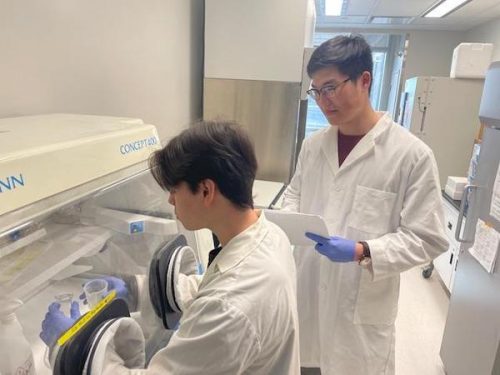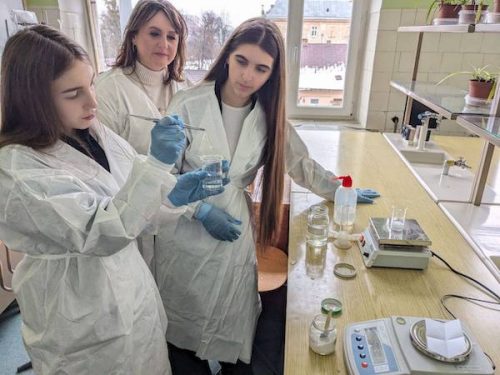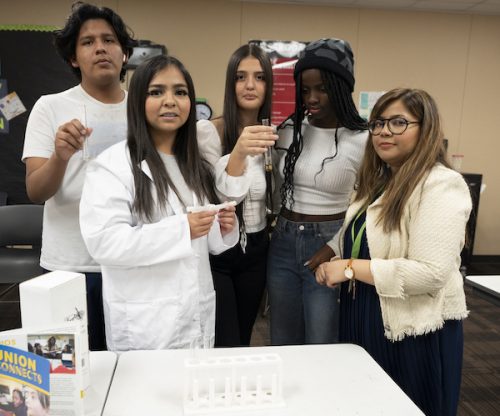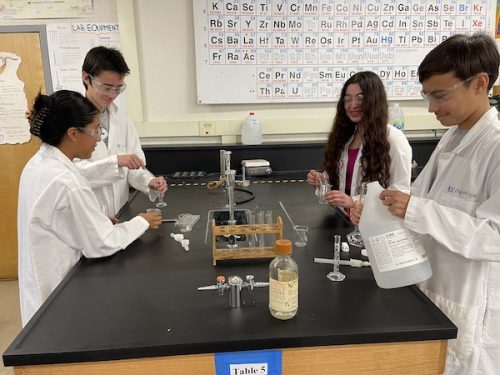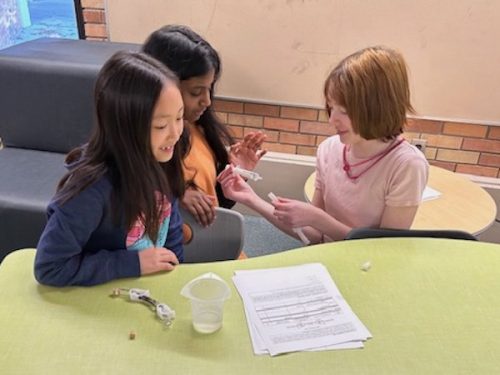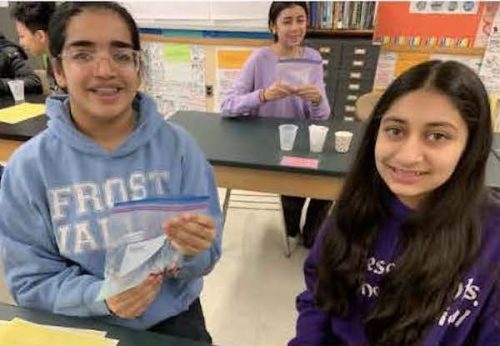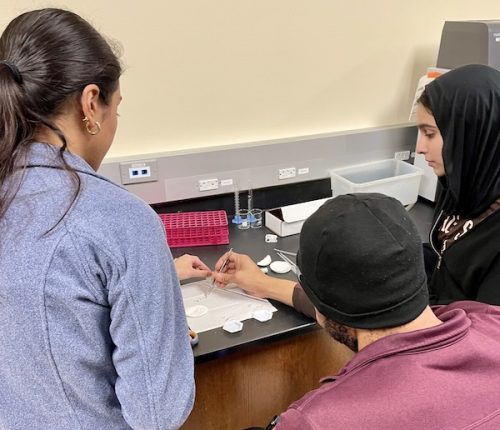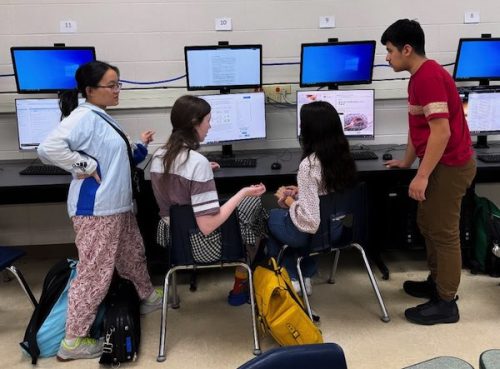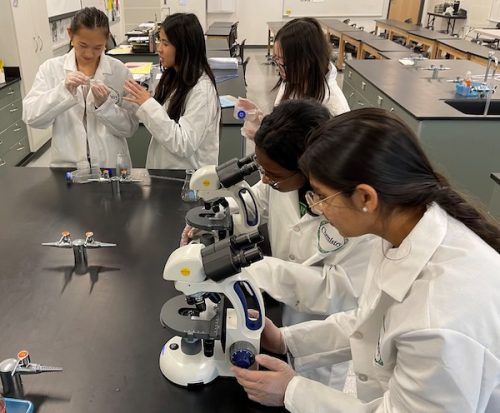Last update of this page: March 28, 2024, 11:29 am ET
The Student Spaceflight Experiments Program is proud to report that there were a total of 1,859 proposals submitted from student teams across the 37 communities participating in Mission 18 to ISS. Of those, 797 proposals were forwarded for review by Step 1 Review Boards in each of the communities. Each Step 1 Review Board selected up to three finalist proposals, which were submitted to the National SSEP Step 2 Review Board.
On November 29 and November 30, 2023 the Step 2 Review Board met at the Goddard Space Flight Center Visitor Center in Greenbelt, MD reviewed the 110 finalist proposals, and selected one proposed experiment to fly for 35 communities and two proposed experiments for two communities, for a total of 39 flight experiments. By December 15, 2023, the National Center for Earth and Space Science Education and the Arthur C. Clarke Institute for Space Education formally notified each community of their selected flight experiments.
It is noteworthy that the 1,859 proposals received reflected a total of 14,253 grade 5-16 students fully engaged in experiment design.
All 110 finalist experiment teams, along with descriptions of their proposed flight experiments, are provided below. You are also invited to meet the SSEP Step 2 Review Board members for Mission 18 to ISS.
Congratulations to the over 14,250 students and their teachers participating in Student Spaceflight Experiments Program Mission 18 to the International Space Station.
Quickly Scroll to Individual Communities
- Edmonton, Alberta, Canada
- Guelph, Ontario, Canada
- Kingston, Ontario, Canada
- Ukraine
- Mesa, Arizona
- Tolleson, Arizona
- Glendora, California
- Lamont, California
- Moreno Valley, California
- Colorado Springs, Colorado
- Loveland, Colorado
- Hillsborough County, Florida
- Viera, Florida
- Pittsfield, Massachusetts
- Oak Park, Michigan
- Edina, Minnesota
- Albany, New York
- Garden City, New York
- Long Beach, New York
- North Tonawanda, New York
- Red Hook, New York
- Grand Forks, North Dakota
- Athens, Ohio
- Kent, Ohio
- Pickerington, Ohio
- Pittsburhg, Pennsylvania – CCAC
- Columbia, South Carolina
- Arlington, Texas
- Burleson, Texas
- Houston, Texas
- Plano, Texas
- San Antonio, Texas
- Texarkana, Texas
- Waxahachie, Texas
- Sandy, Utah
- Chesapeake, Virginia
- iForward-Grantsburg, Wisconsin
1. Edmonton, Alberta, Canada
Jump to Edmonton’s Community Profile
SELECTED FOR FLIGHT:
The Effect of Microgravity on Reproduction of Dugesia japonica
Grade 8, Michael Strembitsky School, Edmonton Public Schools
Co-Principal Investigators: Owen Banfield, Hudson Mohr, Riley Ng, Brett Pascuzzo
Teacher Facilitator: Julie Arsenault
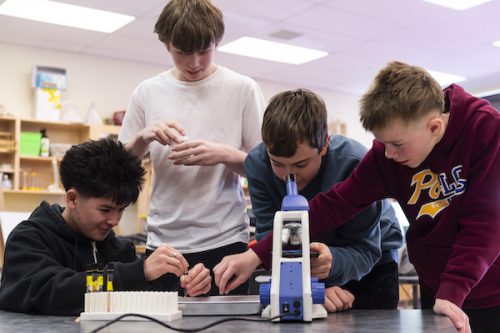
The flight team from Michael Strembitsky School conducting trials on Dugesia flatworms to examine their ability to regenerate and reproduce in microgravity
Proposal Summary:
This experiment tests how microgravity will affect the reproduction of Dugesia japonica. The Dugesia japonica has the ability to regenerate any body part using cells called neoblasts. Neoblasts are a type of stem cell which can regenerate any cell type, which makes D. japonica an ideal model system for studying stem cell reproduction in space. Stem cells are also found in developing human fetuses and bone marrow and are often used to cure certain medical conditions like certain cancers and diabetes. D. japonica also plays a role in aquatic food chains which means this could also be used to start fish farms in a lower gravity environment. D. japonica also consumes dead organic material and algae in water making it cleaner for fish.
HONORABLE MENTION FINALISTS:
Microgravity and its Effects on Wheat (Triticum aestivum) Germination
Grade 8, Michael Strembitsky School, Edmonton Public Schools
Co-Principal Investigators: Ambika Ashta, Shambhavi Pai, Ekam Sandhu, Xirui Zhang
Teacher Facilitator: Julie Arsenault
Proposal Summary:
Wheat (Triticum aestivum) provides many benefits. It contains many nutrients, including vitamin B and dietary fiber which are important for maintaining the nervous system’s health and for keeping the digestive system healthy, respectively. Additionally, it can convert carbon dioxide into oxygen via photosynthesis, which is an important part of the respiration process for humans. If we are able to gain more insight on wheat germination in microgravity, it would give us more information on how germination really works. Wheat would be able to supply astronauts with nutrients and energy. Our experiment involves using a Type 3 FME Mini-Lab so that we can both begin and end germination of the seeds while in space. We will be germinating winter wheat seeds 14 days before they return to Earth using water. Two days before the seeds return, we will use formalin to preserve the germinated seeds in order to analyze them on Earth. Our ground truth sample will follow the same timeline. Once the seeds exposed to microgravity return, we will compare the samples by measuring the root and shoot lengths using a metric ruler and calculating the germination rate.
The Effect of Microgravity on the Growth of Wolffia (Wolffia Arrhiza (L.) Horkel ex Wimm) in Space
Grade 9, Grandview Heights School, Edmonton Public Schools
Co-Principal Investigators: Hajira Penukonda, Ritz Danielle Bugayong
Co-Investigators: Mitchell Chen, Naomi Zhangjiang
Collaborators: Sharon Soyinka, Vidisha Sharma
Teacher Facilitator: Leslie Heinsen
Proposal Summary:
This proposal is an investigation into the world’s smallest flowering plant, Wolffia (Wolffia Arrhiza (L.) Horkel ex Wimm). It is a very nutritional and versatile plant that is highly resistant to environmental changes and, therefore, will be ideal for space exploration and cultivation. It can cover large areas in a very short amount of time and is able to reproduce in more than one way, which makes it an ideal candidate for space, as the conditions in space are unpredictable in the field of botany. The experiment focuses on testing the amount of growth observed in space versus here on Earth, showing how microgravity affects the vital processes of plants, and testing if Wolffia Arrhiza, which is usually very resistant, can hold up to the challenges that microgravity brings in the field of botany. In fact, plants use the processes of cellular respiration and photosynthesis to survive for prolonged periods of time in environments with no new stimuli, as in the experiment. We believe that the Wolffia Arrhiza would be able to survive and even thrive in the circumstances created by this investigation.
2. Guelph, Ontario, Canada
Jump to Guelph’s Community Profile
SELECTED FOR FLIGHT:
Will Soil Bacteria Biodegrade Compostable Plastic in Microgravity?
Grade 6, Alma Public School, Upper Grand District School Board
Co-Principal Investigators: Lily Craven, Will Kelly, Myelle Mulder, Cohen Pearl
Teacher Facilitator: Keri Hons
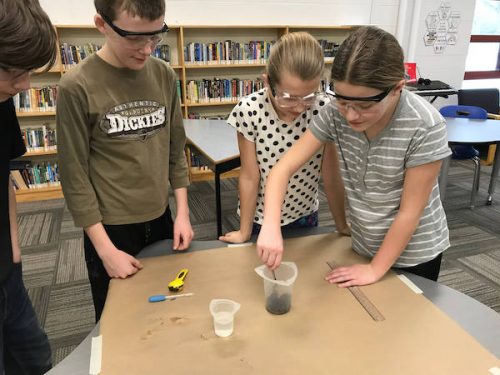
Alma P.S. students removing the sample compostable bag from garden soil following a 10-day period to measure the bag to determine the extent of decomposition.
Proposal Summary:
This experiment will explore if soil bacteria will biodegrade compostable plastic in microgravity. On Earth, people use compostable bags because they can be placed into a compost bin and the bacteria will biodegrade the compostable bag. This experiment is important because if soil bacteria can break down compostable plastic in microgravity it will allow for the collection of food waste in space, which can then be degraded to provide soil nutrients for growing plants. The experiment will need two FME Type 3 mini-labs, one for the control experiment on Earth and one for the microgravity experiment in space. In Volume 2 of each FME mini-lab there will be 12 grams of garden soil mixed with 3 milliliters of tap water. In Volume 1 there will be a piece of a compostable bag that will be added to the soil on day 1 (A=0) of the mission. In Volume 3 of the mini-lab, 6 milliliters of white vinegar will be added and mixed into the soil on day U-2 of the mission. Vinegar kills the bacteria in soil so there will be no biodegradation occurring during the trip back to Alma.
HONORABLE MENTION FINALISTS:
Tetracycline effectiveness on Bacillus subtilis in Microgravity
Grade 8, Ecole Guelph Lake Public School, Upper Grand District School Board
Co-Principal Investigators: Ben Zybala, Joash Matthew, Charlotte Greig, Ella Marit
Teacher Facilitator: David Kaufman
Proposal Summary:
Many microorganisms are influenced by how well antibiotics work against bacteria. One of the numerous issues with studying microorganisms on Earth and in space, is how well medicines work against harmful bacteria. Tetracycline is able to kill or inhibit growth of Bacillus subtilis on Earth. However, this hasn’t been shown in a micro gravitational setting. This proposal’s objective is to look into how B. Subtilis behaves when given Tetracycline. B. subtilis, will be flown to space and combined with Tetracycline to exhibit its efficacy. Many physicians and scientists working in medical facilities will benefit from the results of experiments such as this, when studying various germs and drugs in the future. Also, because this bacteria spreads quickly and often gets closely examined, this experiment would extend the understanding of scientists across different related disciplines. Also, B. subtilis could be present in all living organisms, including outer space scientists. Since Tetracycline is a powerful antibiotic, and B. Subtilis has a low resistance to this antibiotic, this antibiotic should be as powerful against this bacteria in space as on Earth. This experiment with a non-pathogenic bacteria could lead to future research on our understanding of the impact of other antibiotics on pathogenic bacteria that impact human and animal health in microgravity.
Influence of Microgravity on Germination of a Kale Seed
Grade 8, Rickson Ridge P.S., Upper Grand District School Board
Co-Principal Investigators: Grayson Mackinnon, Holden Lindsay, Ivan Li
Teacher Facilitator: Mike Kumbhani
Proposal Summary:
This experiment is made to compare the germination of Kale in microgravity to the germination of Kale in normal gravity. Kale is one of the best leafy greens and has many vitamins and minerals but kale also possesses lots of calcium and magnesium which are both great for bone growth and strength, making it an excellent choice for keeping astronauts healthy in space. Kale can be grown in most climates and is a fast-growing plant usually growing within a span of five to eight days, meaning if it grows just as fast in space as it does on earth it could be a very sufficient food source for the ISS. Harvesting the kale leaves is extremely easy and once its leaves are harvested they will regrow in just a matter of days. Harvested kale leaves can also be frozen and preserved for later consumption but to be safe to eat it should be used within four weeks of being frozen. There have also been studies done that prove that eating kale daily helps the body flush out dangerous toxins, this is because kale contains a molecule that regulates the detoxifying process within our body cells. By the end of the experiment, we will apply a buffer to the seed on Earth and the seed on the ISS at the same time to ensure that we can compare both seeds fairly.
3. Kingston, Ontario, Canada
Jump to Kingston’s Community Profile
SELECTED FOR FLIGHT:
The Impact of Lectins on Escherichia coli Biofilm Formation in Microgravity
Grades 15-16, Queen’s University
Co-Principal Investigators: Grant Hurley, Maisha Maliha, Gurleen Multani, Cole Munro, Tessa Murchison, Ryan Stewart
Teacher Facilitators: Dr. Diane Tomalty, Dr. Olivia Giovannetti
Proposal Summary:
Despite extensive research efforts to develop new antibiotics, the United Nations projects that drug-resistant bacteria will cause 10 million deaths annually by 2050. This public health crisis could force millions of people into extreme poverty in the next decade. Those with compromised immune systems, including astronauts, are at the greatest risk of developing bacterial infections, which are becoming increasingly challenging to treat. Escherichia coli (E. coli) lives inside the human gut and has been identified on spacecraft surfaces and in the air. Since astronauts cannot return to Earth for medical care during long-duration space flights, developing new ways to treat these infections is imperative to combat antibiotic resistance. Without the physical stresses of gravity, E. coli can share genes, proteins, and other molecules that protect them from immune cells and antibiotics more effectively. Bacteria like E. coli also secrete sticky substances that allow them to attach and grow together, forming a biofilm. Lectins are protective proteins made by plants that attach to the sugar chains on the outside of bacteria and can prevent them from forming biofilms. This proposed project would be the first to investigate whether lectins decrease the growth of E. coli in a microgravity environment. The results could lead to a practical opportunity in combining lectins with antibiotics, allowing scientists to enhance their effectiveness for astronauts and immunocompromised patients on Earth. Using lectins to improve current antibiotic treatments is a more feasible and cost-effective solution than spending billions on designing new antimicrobials that will eventually become obsolete.
HONORABLE MENTION FINALISTS:
Examining the Ability of Asialofetuin-A to form Calciprotein Particles in Microgravity
Grades 15-16, Queen’s University
Co-Principal Investigators: Junsu Lee, Wendy Li, Ruairi O’Connor Clarke, Jaimeson Paris Lortie, Joel Sindle
Teacher Facilitators: Dr. Diane Tomalty, Dr. Olivia Giovannetti
Proposal Summary:
Humanity is striving to travel deeper into space than ever, but before this achievement is possible, many problems are standing in the way. One of the most significant issues astronauts face during space travel is the accelerated rate of bone demineralization experienced in microgravity. Humans lose bone density at a rate twenty times greater in space than on Earth; therefore, research must be done on the mechanisms of this bone loss to move toward a solution for keeping astronauts safe. Asialofetuin-A is a type of fetuin-A believed to be specifically important in space biology. This is a protein commonly found in the human bloodstream that chaperones calcium and phosphate to form calciprotein particles (CPPs). Bone demineralization releases calcium and phosphate, which requires asialofetuin-A to balance the levels of these minerals in the blood. This process ensures they do not deposit in tissues and cause further health issues. By researching asialofetuin-A’s ability to chaperone calcium and phosphate in microgravity and comparing it to its ability on Earth, the world can gain a deeper understanding of how microgravity affects the formation of CPPs. These new insights will inform researchers on ways to move forward in developing treatments for microgravity-induced bone density loss and potentially other terrestrial applications. To ensure the safety of people on board, science must take leaps into space exploration so humanity can venture into the stars. This investigation can potentially answer some of the pressing questions stopping humanity from spending extended periods in space.
Space anemia: Investigating the Impact of Microgravity on Erythropoietin for Treatment Implications
Grades 15-16, Queen’s University
Co-Principal Investigators: Anthony Guglya, Kathleen Gardner, Luyang Li
Teacher Facilitators: Dr. Diane Tomalty, Dr. Olivia Giovannetti
Proposal Summary:
It has been well documented that astronauts experience a state of space-induced anemia characterized by a reduction in red blood cell (RBC) count. Space anemia places astronauts at risk for insufficient oxygen delivery throughout their bodies; which may cause symptoms of fatigue, diminished strength, cognitive dysfunction, and impaired heart function. Excessive red blood cell loss also subjects astronauts to iron-overload, which can contribute to risks of bone density loss and organ failure. These issues do not only concern the cognitive and physical health of astronauts, but are also barriers to long-haul space exploration and space tourism. While the mechanism of space anemia remains largely unknown, it has been associated with abnormalities in erythropoietin (EPO) – a crucial hormone that stimulates RBC production. Astronauts exhibit strikingly low EPO concentrations while in space and high levels post-flight, suggesting that EPO functions differently within microgravity. This investigation seeks to determine how EPO’s ability to stimulate RBC production is affected within a microgravity environment compared to standard Earth conditions. Conclusions drawn from this experiment seek to shed light on the mechanisms of space-induced anemia, and the utility of manufactured EPO as a possible treatment. These findings may serve as a catalyst for further research, with hopes of inspiring solutions for improving the physical well- being of astronauts, while also advancing the prospects of long-haul human space exploration. Additionally, these findings may provide valuable insights into improving or developing anemia treatments for applications both in space and on Earth.
4. Ukraine
Jump to Ukraine’s Community Profile
SELECTED FOR FLIGHT:
Production of Biomedical Purpose Hydrogels in Microgravity
Grades 10-11, Skolivsky Secondary School I-III degrees No. 2 named after Stefaniia Vitruk, Junior Academy of Sciences of Ukraine
Co-Principal Investigators: Viktoriia Batko, Sofiia Rudenko
Co-Investigators: Viktoriia Kavchak, Tetiana Malanchuk, Maksym Shvets
Teacher Facilitator: Larysa Romanyshyn
Proposal Summary:
The study aims to evaluate the effect of microgravity on the structure and physical and mechanical properties of hydrogels based on copolymers of 2-hydroxymethacrylate (HEMA) with polyvinylpyrrolidone (PVP). This hydrogel must be placed in an aqueous solution of medical drugs with certain properties (for example, hemostatic, antimicrobial, analgesic) and then applied to the wound. This research will contribute to the development of microgravity materials science. If the synthesis is successful, then based on these substances, with the addition of other components, polymers with other properties can be synthesised by the needs of the ISS. So, it should be possible to reduce the weight of luggage that must be delivered to the ISS. Therefore, hydrogels will be needed in space, especially during long flights to other planets.
HONORABLE MENTION FINALISTS:
Study of Microgravity’s Influence on the Process of Mechanical Tissue Formation During Wheat Germination
Grades 8-9, Municipal extracurricular educational institution “Junior Academy of Sciences for School Students” of the Dnipropetrovsk Regional Council, Junior Academy of Sciences of Ukraine
Principal Investigator: Sophiia Kislova
Co-Principal Investigators: Viktoriia Batko, Sofiia Rudenko
Investigator: Valentyna Vlasenko
Collaborator: Ihor Hryhorovych
Teacher Facilitator: Lykhopavlo Nataliia
Proposal Summary:
Both modern materials and materials with a long history of usage on Earth are extremely important in space flights and exploration of extraterrestrial territories. In our opinion, winter wheat has a number of characteristics that can help mankind survive in extraterrestrial conditions: a valuable food product, ecological building material (stems), and soil nutrients (roots after dying). But Earth’s gravity is necessary for proper plant development. We hypothesize that the formation of ground tissue in microgravity will differ from the Earth’s. The other important factor that will make a difference in the ground tissue formation is heliotropism. Therefore, the study of tissue formation at the cellular level at different values of gravity will make it possible to better understand this phenomenon, and the results can be used to grow tall plants in orbit and to create a device that will create artificial gravity.
Methylene Blue Absorption by Silica Gel in Microgravity
Grade 10, Kharkiv lyceum №47, Junior Academy of Sciences of Ukraine
Principal Investigator: Volodymyr Herasymenko
Co-Investigators: Hlib Linytskyi, Rodion Sorokin
Teacher Facilitator: Andrii Samoilov
Proposal Summary:
The project is focused on the question: how does microgravity affects the absorption process and its effectiveness? We hypothesized that there would be a slight difference in absorption or it would be more effective in microgravity. We chose a model including a silica gel as a sorbent and methylene blue as a substance to be sorbed. Now, at the ISS, silica gels are used as a desiccant for the installation of air purification from carbon dioxide. It can also be used to absorb pollutants and as a sorbent-carrier for catalysts in a solid-phase catalysis. Methylene blue was chosen due to a well-studied and safe substance that can be easily measured quantitatively. But how can we carry out the experiment strictly within the time on the ISS and stop the absorption immediately? We decided to use another “supersorbent” sodium polyacrylate from kids’ diapers. When the silica gel with methylene blue is mixed, the process of absorption starts at the ISS in microgravity. After sodium polyacrylate is added, it quickly absorbs the remaining solution of methylene blue therefore absorption stops immediately. After the mini-lab is returned from the ISS to us, we will manually separate silica gel beads. Then, we will take a photo of colored silica gel beads and measure color intensity by means of ImageJ software. Additionally, methylene blue will be desorbed and quantitatively measured by spectrophotometry. The results of the research may be useful for technology development for purifying water and air as well as for solid-phase catalyst creation.
5. Mesa, Arizona
Jump to Mesa’s Community Profile
SELECTED FOR FLIGHT:
The Growth and Mutation of Staphylococcus (Epidermidis) Biofilm in Microgravity
Grades 4-5, 9 and 12, Red Mountain High School, Zaharis Elementary School, Red Mountain Ranch Elementary School, Mesa Public School District
Co-Principal Investigators: Ella McTaggart, Emma Randall
Co-Investigators: Jack Anderson, Kristen Colborn, Christian Kim, Elizabeth Miller, Bryson Parker, Lilly Roberts, Kambel Schulze
Collaborators: Joel Ortega, Sophie Mills, Gianna Martellaro, Sumer McVey, Payton Hiltner, Farmanullah Khaliq, Emma Paquet, Lyrik Thomas
Teacher Facilitators: Jennifer Klein, Dr. Nancy Darling, Kyle Williams
Proposal Summary:
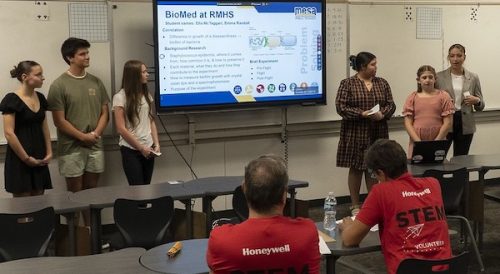
Mesa Publc School students work together presenting their critical design review to their industry partners Honeywell Aerospace Technologies in their successful bid to be a finalist for SSEP Mission 18.
The safety of astronauts is of the utmost importance; they take society into a new era of discovery. Staphylococcus Epidermidis is a common symbiont bacteria that can become infectious upon entering a human host. The infection can lead to many unfortunate complications, especially among astronauts in microgravity. The bacteria produce biofilm upon entering the body (through an overgrowth on the skin or medical devices). This biofilm acts as a defense against the human immune system. This investigation will compare the evolution of Staphylococcus Epidermidis in microgravity to that on Earth by analyzing the growth of its biofilm. In the experiment, the freeze-dried Staphylococcus Epidermidis bacteria will be placed in an FME tube along with Soy Broth and 10% Neutral Buffered Formalin securely separated by clips. Once in space, the Soy Broth will rehydrate and feed the Staphylococcus; later, the 10% Neutral Buffered Formalin will safely stop the growth of the bacteria towards the end of the experiment. Evaluating the growth of Staphylococcus’s biofilm in microgravity and how it differs on Earth, will provide a better understanding of how astronauts can be protected. With health risks set aside, astronauts can put their time and energy into critical research that will enhance the world and better our future.
HONORABLE MENTION FINALISTS:
The Effect of Calcitonin on Bone Mass of Femur in Rat not treated with Formaldehyde
Grades 5-6, 9 and 12, Red Mountain High School, Mendoza Elementary School, Las Sendas Elementary School, Mesa Public School District
Co-Principal Investigators: Brooklyn Anaya, Emily Deiss, Sierra Fry, Shriya Patel, Kaelyn Udall, Ellie Woolf
Co-Investigators: Logan Skelton, Cienna Valencia
Collaborators: Ian Patterson, Ryelyn Mootoo, Flynn Stone, Torri Franzone, Kennedy Bergstrom, Olivia Skidmore, Victoria Green, Bennett Morrow, Ryan Lundell, Beckham Anderson, Everett Cherry, Ruby Ribic, Kaylee Stiles, Vivian Workman
Teacher Facilitators: Jennifer Klein, Dr. Nancy Darling, Kyle Williams
Proposal Summary:
As space exploration increases in the race to gain knowledge of the universe, the physical dangers of microgravity become more apparent. Osteopenia, in terms of spaceflight, describes the loss of bone mass in microgravity environments. Osteopenia is a much more common occurrence in space due to microgravity because bones are not as heavily utilized to support the body in space as on Earth. A common treatment used to combat osteopenia on Earth is calcitonin, which initiates the contraction of osteoclasts. Osteoclasts are cells within the bone responsible for the degradation of bone, causing a loss of bone mass. By inhibiting osteoclast activity, calcitonin effectively reduces this loss of said mass. In this experiment, the data gathered will determine if a calcitonin treatment will affect the rate of bone mass loss when in a microgravity environment. If humankind is to continue exploring vast and unknown galaxies, there must be a way to protect astronauts from osteopenia, and this experiment will explore a potential method of doing so.
The Effect of Microgravity on Lactobacillus GG’s Acidogenesis Process
Grades 4-6, 9 and 11, Red Mountain High School, Jefferson Elementary School, Red Mountain Ranch Elementary School, Mesa Public School District
Co-Principal Investigators: Anaiz Daniels, Amelia Guerin, Sereniti Johnson, Alexis Kelley, Caden Romero, Katie Wong
Co-Investigators: Kasey Fox, Alexander Goode, Jackson Huston, Kaylee Trout
Collaborators: Odin Jacobs, Kylan Nailer, Gauge Price, Etsamani Hernandez, Marylin Garcia, Keily Lugo, Laynie Hurff, Hunter Michel, Norah Stobie, Julio Gomez, Brantley Moore, Leonella Rodriguez, Zoe Hendrix, Caleb Flores, Mikole Childress, Grayson Soto, Hazel Goble, Evalynne Woodworth, Thomas Bonney, Finn Brown, Blake Bunch, Grace Bycott, Madison Dickerson, Leon Woods
Teacher Facilitators: Adam Middleton, Kyle Williams
Proposal Summary:
Anaerobic digestion is an environmentally sustainable and economically viable process for organic waste management and renewable energy production. This process harnesses the natural decomposition of organic materials by microorganisms in an oxygen-free environment to generate biogas. Lactobacillus rhamnosus (LGG) is a bacterium that plays a major role in the process of anaerobic digestion. In this experiment, the ability of this bacterium to create acids is assessed using mass spectrometry. The organic waste from astronauts will be converted into a renewable and environmentally friendly energy source. If the test is successful, astronauts will be one step closer to using their waste as a natural energy source that will not only help keep the environment clean but also give them more energy throughout their space missions.
6. Tolleson, Arizona
Jump to Tolleson’s Community Profile
SELECTED FOR FLIGHT:
Does the Arabidopsis Seed Grow in the Test Tube without Gravity?
Grade 8, Dos Rios Elementary School, Union Elementary School District No. 62
Principal Investigator: Clementine Mukeshimana
Co-Investigators: Merlyn Montoya Lopez, Maryjane Hernandez, Mariano Sunn
Teacher Facilitator: Dr. Saima Afroze
Proposal Summary:
The question we are focusing on for our experiment is whether Arabidopsis seeds can grow in a test tube without gravity. The idea is to find the answer to the following questions: whether the seeds can germinate and develop properly in microgravity. We will be checking two variations; first if the seed will germinate in microgravity, and second if fertilizer will help the seed to grow. We chose Arabidopsis seeds because research has shown that they can be used in treatments that will be helpful for future human colonization. Additionally, they are inexpensive to grow and have a rapid life cycle (about 6 weeks from germination to mature seed) making them easy to cultivate in restricted space.
HONORABLE MENTION FINALISTS:
Can Cremini Mushrooms Grow without Gravity?
Grade 8, Dos Rios Elementary School, Union Elementary School District No. 62
Co-Principal Investigators: Christopher Perkins, Dayan Toyo, Edward Gachihi, Geovonny Wright
Teacher Facilitator: Dr. Saima Afroze
Proposal Summary:
We propose to answer the question: Can the Cremini Mushroom grow normally in microgravity/how is the Stalk height, stalk diameter/cap diameter affected by the microgravity? Through research, we have found that cremini mushrooms have high protein content as well as other factors such as carbohydrates, low fat, calories, and the ability to lower blood pressure. This research on cremini mushroom on microgravity will help us determine if the effects of microgravity will alter the cremini mushroom in any way, specifically in terms of physical size stalk height, and stalk diameter/cap diameter of the mushroom. Additionally, during pregnancy, the consumption of cremini mushrooms can help regulate the mother’s blood pressure, ensuring the health of the baby. The collection of the valuable data will be helpful for the development of space agriculture, food production system and future colonization in low gravity environments.
Checking the Dormant State & Survival of Tardigrade in Microgravity/Space?
Grade 8, Dos Rios Elementary School, Union Elementary School District No. 62
Co-Principal Investigators: Jayleen Escobar, Angelina Gonzalez, Daniela Garibay, Juan Cardoza, Justin Henry
Teacher Facilitator: Dr. Saima Afroze
Proposal Summary:
The focused question of the experiment is whether Tardigrades can be useful in space just like they are on Earth. Tardigrades are microscopic (0.05 to 1.5 millimeters) and can survive in extreme temperatures, pressures and even radiation. They are known to be the most resilient animal on Earth. They turn themselves into a dormant form where they shrivel up into a ball expel most of the water and lower their metabolism until they enter an environment better suited for sustaining life. They are omnivores and eat algae and small invertebrates. Tardigrades help break down organic matter and are a source of food for other small animals. Tardigrades may have the ability to help astronauts survive long spaceflights. In space tardigrade can be used to engineer food crops, yeast, and insects to produce tardigrade protein.
7. Glendora, California
Jump to Glendora’s Community Profile
SELECTED FOR FLIGHT:
Cyanobacteria (Trichormus variabilis): Growth in Extreme Conditions of Microgravity, Radiation, While in Extended Darkness
Grade 10, Glendora High School, Glendora Unified School District
Principal Investigator: Saphira Prakash
Co-Investigators: Janell Jimenez, David Scott
Collaborator: Jaden Vibberts
Teacher Facilitator: Chris Alertas
Proposal Summary:
Cyanobacteria are evolutionarily crucial organisms that facilitated an explosion of life-forms on Earth, due to evolving metabolic pathways, including photosynthesis, nitrogen fixation, and oxygen production. There is significant interest in determining whether cyanobacteria can be transported to the moon and Mars to be useful for terraforming these celestial bodies into Earth-like conditions. This investigation will compare the growth rates of a freshwater cyanobacteria strain, Trichormus variabilis (formerly Anabaena variabilis), on Earth to conditions on the International Space Station: microgravity, and higher radiation, while in extended darkness. This study will help determine if it is a good candidate for future space missions. Cyanobacteria are highly efficacious photosynthesizers. Hence, they recycle waste gasses while producing breathable oxygen from minimal light. Many strains reproduce quickly and need minimal space and resources (such as an inorganic carbon source and a few photons) to survive. Trichormus variabilis was chosen for this experiment for several reasons: 1. It has important characteristics that would make it potentially useful for future long-term space travel including potential biofuel, cell resilience, biomedical, agricultural, and phytoremediation of toxic environments. 2. To our knowledge, it has never been studied in space. 3. Like other cyanobacteria, it recycles carbon dioxide, fixes nitrogen, and produces breathable oxygen. This study will help determine if this strain of cyanobacteria may be beneficial for use in future colonization purposes. If it can thrive and endure prolonged periods of low light, radiation, and microgravity, it would represent a significant stride forward in our quest to terraform extraterrestrial locations.
HONORABLE MENTION FINALISTS:
The Influence of Microgravity During the Crystallization Process of Salt
Grade 12, Glendora High School, Glendora Unified School District
Co-Principal Investigators: Thomas Chavez, Shawn Ho, Jonathan Villegas, Mitchell Zepeda
Teacher Facilitator: Chris Alertas
Proposal Summary:
The proposed study aims to demonstrate the impact of microgravity on the crystalline structure of sodium chloride (NaCl). Salt’s crystalline structure, mainly cubic, has been thoroughly studied under terrestrial conditions; however, microgravity presents a unique environment where sedimentation, convection, and hydrostatic pressure are reduced mainly, potentially altering crystal formation dynamics and properties. This research hypothesizes that microgravity will induce changes in crystal morphology, size distribution, and defect density compared to Earth-grown counterparts. Employing a methodical approach, utilizing the microgravity conditions aboard the International Space Station (ISS) to grow NaCl crystals. The study’s outcomes present potential valuable contributions to the field of crystallography and materials science, with possible applications in the synthesis of certain materials and pharmaceuticals. From research on the formation of the crystalline structure of NaCl in microgravity, understanding salt crystallization could have implications for life support systems in space exploration, where salt could play a valuable role in water recovery and air purification systems as well as establishing industrial applications for terrestrial and extraterrestrial use. Therefore, one could see that the production of salt within a microgravity environment could be very helpful and useful to further enhance our advancement into space exploration as well as in the future, where we may explore other planets and be able to live on them.
The Effects of Microgravity on the metabolism and growth Physarum polycephalum (slime mold)
Grade 11, Glendora High School, Glendora Unified School District
Principal Investigator: Christopher Lai
Investigator: Alan Barnes
Teacher Facilitator: Chris Alertas
Proposal Summary:
The colonization of other planets and the rise of effective and long-term spacefaring projects are both inevitable and relevant topics that become more prevalent every day in today’s changing climates. One of the many particular and necessary studies within the realm of successful colonization and traversal beyond this planet is the effective subsistence of agriculture in space. This experiment will investigate the possible use of slime molds as compact and tolerant species of decomposers of cellulose material in space – in pursuit of finding an alternate method of composting and relevant new information on breaking down agrarian byproducts in space. The investigation aims to study the effects of microgravity on the metabolism and growth of the Physarum polycephalum slime mold by measuring and comparing the vertical growth and digestion of nutrients in low Earth orbit opposed to Earth. Slime molds in normal gravity grow horizontally with a creeping motion as they pursue, cover, and consume food; however, within the experiment, they will be grown under the effects of microgravity, which will possibly prove to accelerate the growth and metabolic rate of this process.
8. Lamont, California
Jump to Lamont’s Community Profile
SELECTED FOR FLIGHT:
Effects of Microgravity on Lactuca sativa
Grade 8, Mountain View Middle School, Lamont School District
Co-Principal Investigators: Permission to post names pending
Teacher Facilitator: Aaron Kelly
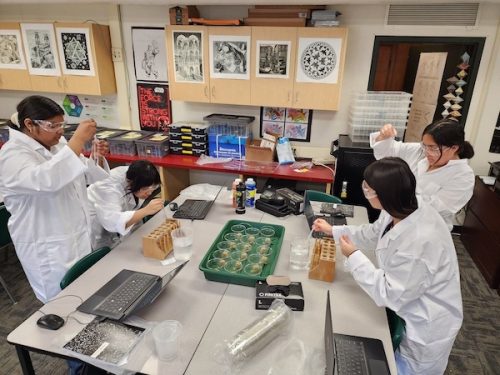
Lamont Community Winners cultivating knowledge through Spinacia oleracea seed germination research 🌱 #WeAreLESD #SomosLESD
Proposal Summary:
Our experiment is all about finding out if Lactuca sativa does germinate under microgravity. We picked Lactuca sativa because we found out that it’s beneficial for us humans and the astronauts in space, and we guessed that it would help us find additional ways to help us and keep the astronauts healthy and strong while on a space mission. To do our experiment, we used Rockwool (substrate), Distilled Water, a Fixative (Formalin), and Lactuca Sativa seeds, to see the differences that would occur while germinating in space with the same materials. During our test, we plan to put 3 mL of Distilled Water, 2 cubic cm of Rockwool, 10 Lactuca Sativa seeds, and 3 mL of Formalin into our volumes on our Type 3 FME Mini-Lab to see if our seed germinate differently in space as compared to on Earth. We have conducted research to make sure we understand the germinating process here on Earth. We looked for facts from different articles to make sure we plan a procedure that mimics the environment on the ISS. To understand how hot or cold it is in the ISS, we thought about the temperature range which is about 22 to 23 degrees Celsius, which helped us know what our ground experiment procedure should be. When planning our test, we set up a course of action for day 2 crew interaction days, one to start the experiment and one to stop it. This helps us control for time in our experiment.
HONORABLE MENTION FINALISTS:
The Effects of Microgravity on Grapes
Grade 8, Mountain View Middle School, Lamont School District
Co-Principal Investigators: Permission to post names pending
Teacher Facilitator: Aaron Kelly
Proposal Summary:
Our experiment is all about finding out if my grape seed does germinate under microgravity. We picked grapes because of its benefits for the human body and surrounding environment for space travel, and we guessed that it would help improve astronauts’ diet with necessary nutrients. To do our experiment, we used the FME lab container to contain the seed. During our test, we put 10 grape seeds into FME lab containers to see if microgravity affects plant growth. On a certain day in space or on Earth, we plan to unclamp clamp A to put the seeds and distilled water in the container. We looked for facts from articles to make sure we provide suitable substrate, Rockwool, for imbibition step of seed germination. To understand how hot or cold it is in the ISS, we thought about the temperature range, which helped us know how long the plant growth might take. When planning our test, we set up a fixative for day U-2 to stop the seeds from growing to match the other experiment on Earth. This part was super important because it helped us keep the labs just right at a specific time, so we could compare them to the experiment on Earth in the regular group.
The Effects of Microgravity on a Cucurbita Pepo (pumpkin)
Grades 7-8, Mountain View Middle School, Lamont School District
Co-Principal Investigators: Permission to post names pending
Teacher Facilitator: Aaron Kelly
Proposal Summary:
Our experiment considers the effects of microgravity on Cucurbita pepo germination process. We picked Cucurbita pepo because our team wanted to determine if our plant’s weight and size would affect its growth while it is in space. Room to grow is a potential problem as Cucurbita pepo has a large amount of weight. We plan to conduct two experiments, one on Earth called our ground experiment, and put one sample into an FME bound for the ISS. We plan to control for the amount of time the seeds have to germinate by starting and stopping both experiments with the same amount of time in between. When planning our experiment, we set up only 2 crew interaction days: one to start and one to stop. To see what the difference is between growing it on Earth and growing it in space. A formalin fixative is used the experiment to stop both experiments at a given time, and to preserve the seedlings for future comparisons. In our research we looked for facts from previous studies and discoveries that other scientists have done before us, to make sure we had background on Cucurbita pepo and its normal growth patterns. We considered the temperature ranges on the ISS, which is about 22-23 degrees Celsius, helping us plan for growing a Cucurbita pepo and what temperature to keep our ground experiment.
9. Moreno Valley, California
Jump to Moreno Valley’s Community Profile
SELECTED FOR FLIGHT:
The Effects of Microgravity on Arugula
Grades 7-8, Landmark Middle School, Moreno Valley Unified School District
Co-Principal Investigators: Daina Brambila, Zion Greenland, London Lawson, Benjamin Seay-McGee, Sarah Smith
Teacher Facilitator: Deborah L Collins
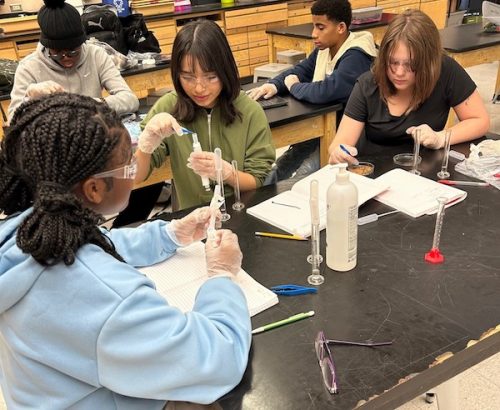
Can arugula survive the spacewalk? An MVUSD science whiz explores the effects of microgravity on this popular leafy green.
Proposal Summary:
The team will be analyzing the effects of microgravity on Eruca Sativa (arugula) seeds. The team will analyze this proposal by sprouting arugula seeds on Earth in the same environment as if they were in space under the same conditions at the same time. The team will be talking about the benefits and the disadvantages of arugula and why you should choose arugula to take to space.
HONORABLE MENTION FINALISTS:
The Effects Microgravity Has on the Rate of Growth of Mold on Fresh Bread
Grades 11-12, Valley View High School, Moreno Valley Unified School District
Co-Principal Investigators: Matthew Llamas, Polsak Pang, Martin Ramirez
Teacher Facilitator: Stacy Katzenstein
Proposal Summary:
This experiment will be conducted to test the effects microgravity has on the growth rate of mold. Mold growth in microgravity is plausible and has been documented growing naturally on the ISS, but there needs to be more thorough research conducted and experimenting regarding mold growth. This experiment intends to bring more documentation regarding the elements of growth, i.e. speed of growth, time taken to spread, and percentage growth throughout a window of 4-6 weeks while in the ISS and to be examined when brought back down for comparison and analysis with the ground truth experiment. In addition to the rate of growth, possible other observations might be colors or types of mold. These observations can help us understand how mold behaves while in a zero gravity environment with the absence of gravity, our independent variable, to theoretically affect the mold growth rate. The experiment aims to produce results regarding the growth rate, and the difference between the growth in microgravity and on earth; this can be used as reference material, providing further information to increase the documentation of this topic.
The Effects of Microgravity on the Germination of Tomato seeds
Grade 11, Valley View High School, Moreno Valley Unified School District
Co-Principal Investigators: Ivan Castillo, Joshua Cordon
Teacher Facilitator: Salvador Martinez
Proposal Summary:
To test and see if microgravity will have any effect on the germination of tomato seeds. If the experiment’s outcome shows that the germination progress speeds up, or even conveniently, it can alter the way tomatoes are cultivated and produced. Tomatoes could be grown in the ISS as they don’t take up much space through vertical gardening, and they can be used in a wide variety of meals such as tomato soup, its use in salsas, and to make salads. It can be an excellent healthy addition to astronauts floating around in space.
10. Colorado Springs, Colorado
Jump to Colorado Springs’ Community Profile
SELECTED FOR FLIGHT:
Calcium Sulfate Crystal Growth in Microgravity
Grades 13-16, University of Colorado Colorado Springs and Pikes Peak State College
Principal Investigator: Luke Davis
Co-Investigators: Noah Grebe, Blake MacDonald
Teacher Facilitator: McKenna Lovejoy
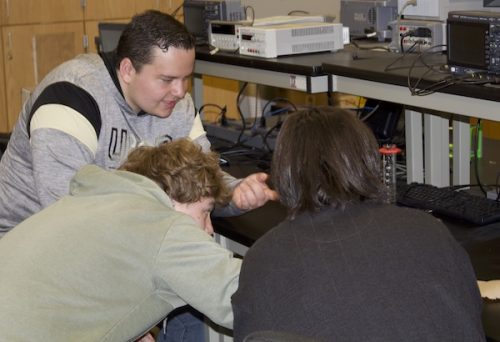
Colorado Springs students Noah Grebe, Luke Davis, and Blake MacDonald observing crystal growth in a 1G environment.
Proposal Summary:
The proposed flight experiment will investigate microgravity’s effects on the formation of inorganic crystalline structural growth, and use, within a controlled setting. Calcium sulfate crystals are commonly used in a wide range of projects from building materials to food additives and fertilizers. Larger and more pure instances of this substance created in microgravity will prove useful in future space exploration missions as a high-quality fertilizer that can be produced on orbit. The experiment will be handled by mixing a volume of aqueous sodium sulfate with aqueous calcium chloride, which will react to form a precipitation of calcium sulfate dihydride and crystalize over an extended period on orbit. This process will give way to the crystallization of calcium sulfate, occurring both on Earth and in microgravity. The purpose of this investigation is to analyze and compare the size, structure, and purity of the resulting crystalline formations with varying prescience’s of boundary forces and other gravitationally based influences. The research being proposed within microgravity conditions with inorganic crystal structures will analyze the possibility of altered lattice structure formation, which will give insight into the involvement of how forces play a role in crystallization. If a larger, more pure calcium sulfate crystal can be shown to grow in microgravity, this substance can be used more effectively in many applications in space mission and be produced on orbit as required, leading to a significant impact on future space missions.
HONORABLE MENTION FINALISTS:
The Effects of Microgravity on the Growth of Akkermansia Muciniphila
Grades 13-14, University of Colorado Colorado Springs and Pikes Peak State College
Co-Principal Investigators: John Britton, Alex Cheshmedjiev, Reagan Otten, Sequan Valle, Lincoln Wieck
Teacher Facilitator: Dr. Peter Gorder
Proposal Summary:
The objective of this experiment is to determine if a common probiotic known as Akkermansia muciniphila can sustain its growth rate in microgravity and thus maintain sufficient nutritional value. A. muciniphila is an anaerobic mucin-degrading bacterium found in the intestinal microbiota. The human intestinal lining is composed of epithelial cells, which are covered in a mucus layer made of mucin protein. A. muciniphila feeds off the mucin, which encourages the epithelial cells to increase production, boosting gut health. A diverse gut microbiota is essential to the prevention of disease and maintenance of overall health. A. muciniphila has been linked to the prevention of metabolic and inflammatory disease. If the bacterium can be grown at a feasible rate, it can be administered as a probiotic to supplement the health of astronauts. To test this, the cultivation of A. muciniphila will be compared in vitro under the conditions of Earth’s gravity versus microgravity by analyzing the biomass. The bacterium will be in powdered form and then mixed with a growth medium. After the test period, the A. muciniphila will be exposed to a fixative within the test tube in space and in the control to inhibit further growth and enable comparison. If the growth rate efficiency is sufficiently comparable and feasible to grow autonomously, A. muciniphila could be used as a supplement for astronauts aboard the International Space Station. Being able to cultivate and administer probiotics in space is essential to the advancement of space travel as it would support astronaut health during longer missions.
Cleanliness in Microgravity: Crystallization Behavior of Borax
Grade 16, University of Colorado Colorado Springs and Pikes Peak State College
Co-Principal Investigators: Amara Demetrelis, Mason Smith, Natalie Allen (Young)
Teacher Facilitator: Dr. Lynnane George
Proposal Summary:
Living in environments outside of Earth requires a fundamental understanding of basic survival factors encompassing shelter, energy, sustainability, and sanitation. Cleanliness in microgravity is instrumental to sustaining human life because space travel requires long periods in confined spaces where infectious diseases can run rampant. Currently, there are limited options for basic cleanliness on the International Space Station such as anti-microbial wipes used to wipe down surfaces, limited clothing changes, and sponge baths. On Earth, under standard gravity conditions household cleaners are particularly adept at penetrating and removing varying degrees of germs and everyday filth through diffusion processes. However, under microgravity conditions, this process may be altered. Gathering more information regarding the diffusion process of Borax is a key element in determining whether it is safe to use long-term in microgravity conditions. Borax is a cheap, obtainable, and versatile household cleaner used to sanitize various surfaces. The proposed investigation into the diffusion process of Borax aims to observe its crystallization and diffusion behavior under microgravity compared to gravity conditions. The results obtained can potentially expand the cleanliness options available during future space missions.
11. Loveland, Colorado
Jump to Loveland’s Community Profile
SELECTED FOR FLIGHT:
Cucurbita Maxima Seed’s Germination in Microgravity
Grade 7, High Plains School, Thompson School District R2-J
Co-Principal Investigators: Lee Soyland, Maelle Webb
Co-Investigators: Aiden Gondalez, Conor Greene
Collaborator: Zachary Collins
Teacher Facilitator: Aaron Estevez
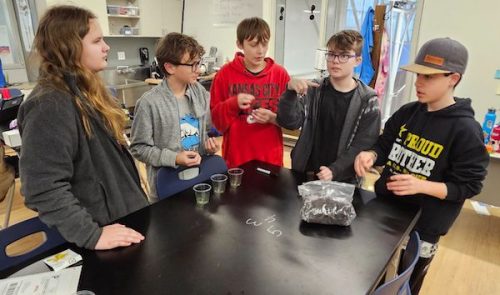
Maelle Webb, Conor Greene, Aiden Gonzalez, Lee Soyland, and Zachary Collins reflect on the impact of microgravity on seed orientation and discuss the protocols for seed germination trial experiment.
Proposal Summary:
The investigation of Cucurbita maxima seed (winter butternut squash) and its germination in microgravity will affect advanced farming practices in space and on Earth. The experiment will be sent up into the International Space Station (ISS)–in microgravity. A similar germination experiment will be executed at the same time in Loveland, CO as a ground control experiment to compare results once both FMEs are brought back into High Plains School to be given a traditional plant’s care. To support this plan, multiple sources have conducted a similar trial before and have proven the possibility of germination in microgravity so these seeds have a strong germination rate (85%). By sending a Cucurbita maxima seed into these conditions then bringing the specimen back to be planted and grown on Earth with the effect of gravity, the experiment could help prove the effectiveness of growth in microgravity and efficiency in farming on land. Furthermore, this investigation could revolutionize long term space missions. If the experiment proves that germination in microgravity is successful, researchers will be able to incorporate this realization to future expeditions. With plentiful resources, increased complex trips would be able to take place and the rocketship will need less fuel for the weight of food. To conclude, this assessment teaches more about overall plant growth, and how this examination can improve Earth’s agriculture and ability to travel in space.
HONORABLE MENTION FINALISTS:
How do White Blood Cells Fight Rhinovirus Cells in Microgravity?
Grade 7, High Plains School, Thompson School District R2-J
Co-Principal Investigators: Cooper Nelson, Ryan Konecny
Investigator: Danny Tyszko
Collaborator: Marcus Robinson
Teacher Facilitator: Aaron Estevez
Proposal Summary:
The possibility of astronauts being harmed in microgravity by a very common illness is very unsought. The common cold (Rhinovirus) allows other viruses to invade the body. Rhinovirus does this by in a way distracting the body while other diseases enter. The white blood cells in the body fight infection and prevent disease. This investigation will determine how microgravity affects the strength of (human) white blood cells fighting against the rhinovirus. The average recovery time in an average adult is 7 days (Johns Hopkins Medicine). However, having the rhinovirus in space can be very different, and possibly dangerous. This goes to show just why this experiment is crucial to undergo. This experiment is crucial because if the common cold (Rhinovirus) gets stronger, or weaker, then astronauts who may carry the virus, could suffer very badly as a result. The experiment will only take 10 seconds to start and then require no more interaction. This is because the experiment will work mostly on its own. Furthermore, the experiment will not take up more than 10 seconds unless the crew on ISS takes longer.
Will Azithromycin Affect E. Coli Differently when under Microgravity Conditions?
Grade 7, High Plains School, Thompson School District R2-J
Co-Principal Investigators: Stefania Wiant, Miles Patterson
Co-Investigators: Jett Sandborgh, Mitchell Watts, Cody Lenhart
Teacher Facilitator: Aaron Estevez
Proposal Summary:
How does microgravity (MG) affect the treatment process of Azithromycin to Escherichia coli (E. coli)? E. coli is known for giving stomach cramps, diarrhea, and other bodily disorders. E. coli cells have been proven to grow at a reduced rate and become significantly smaller after being treated with antibiotics. This experiment will explore the differences in E. coli after being treated with Azithromycin in microgravity compared to Earth. Because E. coli is highly contagious and reproduces relatively fast, one case of it in the ISS could cause a huge problem. Being in space already weakens the astronauts’ health by bone loss, and all spacecrafts have cramped conditions and recycled air (ideal for bacteria spread.) By seeing how E. coli cells improve or degrade with treatment in microgravity, this experiment will revolutionize how illness is treated in space, and could reveal new treatment methods that work better on Earth.
12. Hillsborough County, Florida
Jump to Hillsborough County’s Community Profile
SELECTED FOR FLIGHT:
Fenugreek and its Nutritional Value in Microgravity
Grade 7-9, Randall Middle School, Hillsborough County Public Schools
Co-Principal Investigators: Sanjana Rao, Aadrita Roy
Co-Investigators: Nathan Bohra, Crystal Heidenreich, Lonappan John
Teacher Facilitator: Mary Vaughn
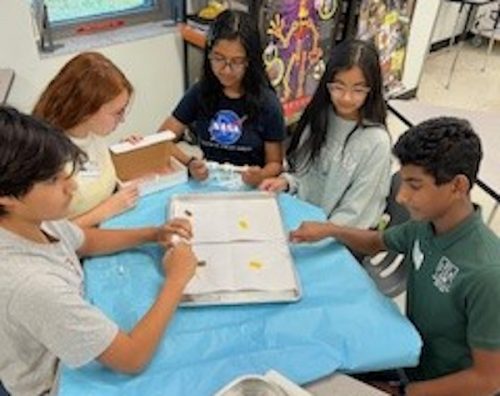
Students working to optimize the materials and volumes for testing the growth of Trigonella foenum-graecum in microgravity.
Proposal Summary:
The Fenugreek team is testing Fenugreek growth in microgravity. The question is “Does microgravity slow the growth of Fenugreek affecting it’s nutritional value?” Analyzing this microgreen is crucial, to answer the essential question, and to create a reliable food source for astronauts. Another reason Fenugreek can help astronauts is it provides a rich source of calcium which is known to increase bone mass. Therefore, making it vital to astronauts as they can lose up to 20% of bone mass in microgravity. Fenugreek not only has calcium, but also many other nutrients. To address the question posed, the nutritional values of Fenugreek in microgravity and on Earth must be compared. A Brix Refractometer measures the nutritional value of any variety of solids, like Fenugreek. Our team will use the Brix Refractometer upon Fenugreek’s return to Earth. As we complete post-flight analysis, we will measure the nutritional value of the sample from the ISS compared to the nutritional value of Fenugreek on Earth. The team will then be able to compare the results and finally answer the essential question. Our faction knows Fenugreek can be grown in the span of 30 days (about 4 and a half weeks), since the germination rate is 2-5 days. Due to these factors, it would be beneficial to test Fenugreek growth in microgravity and see if this could be a potential food source for astronauts.
Handy, Dandy Dandelions
Grade 7, Randall Middle School, Hillsborough County Public Schools
Co-Principal Investigators: Bridget Bohan, Jade Thorn
Teacher Facilitator: Mary Vaughn
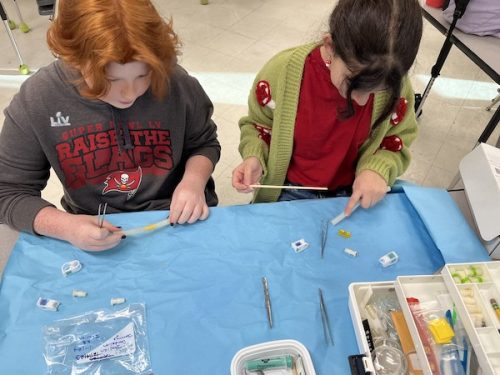
Seventh grade researchers from Randall Middle School working on optimizing their Taraxacum officinale germination experiment for flight.
Proposal Summary:
This investigation explores the effects of microgravity on the hydroponically grown common dandelion, Taraxacum officinale, to obtain information on whether it can properly grow and change in microgravity. The team will be looking at changes in its physical properties and cell composition in hopes of observing growth rates in microgravity. The team also plans to use microscopy to analyze cell changes and if microgravity negatively affects the dandelion. The basis for this investigation includes the prior knowledge that the common dandelion contains numerous health benefits. The hypothesis is that microgravity may increase the frequency rate of the germination of common dandelion, Taraxacum officinale, and will support the growth of this herbaceous plant. If microgravity supports the growth, then the common dandelion will be a sustainable food source to grow in microgravity. The growth of the Taraxacum officinale will also provide evidence supporting if it could be a practical crop for long duration missions and future stays at the ISS.
13. Viera, Florida
Jump to Viera’s Community Profile
SELECTED FOR FLIGHT:
How do Tardigrades Preserve Hemlibra Medication in Microgravity?
Grade 8, Pinecrest Academy Space Coast, Brevard County Public Schools
Co-Principal Investigators: Cameron Winchester, Baylen Wreggit, Chase Elden-Moore
Teacher Facilitator: Consuelo Praetorius
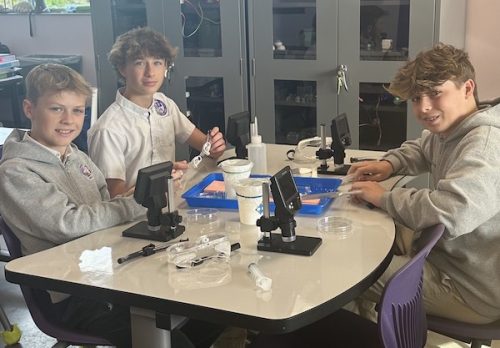
2024 Pinecrest Academy Space Coast Mission 18 Winning Team, Cameron Winchester, Chase Elden-Moore and Baylen Wreggit experimenting on tardigrades extending the efficacy of Hemlibra.
Proposal Summary:
Our scientific question is how do tardigrades help preserve hemophilia medication in microgravity. This experiment is important because it will extend the amount of time it takes for hemophilia medication such as hemlibra to spoil. The importance of having longer lasting medicine is that it is more versatile and can be transported far away to places like space. While you are in space you do not want to have to keep traveling hundreds of thousands of miles wasting millions of dollars on fuel every time you have to replenish the medicine supply. It will benefit mankind because blood thinning is a huge issue in space and being able to have long lasting medication for it will save lives.This experiment should be conducted in microgravity because there is increased radiation which affects the shelf life of the medication. Also in outer space there is a big blood thinning issue so this would increase the amount of time the astronauts can stay in outer space. This shouldn’t be conducted on Earth because although blood thinning is still in issue on Earth it is caused more often in space due to microgravity causing body fluids to shift. Tardigrades, distilled water, and hemlibra medication are our three samples in the experiment. We believe that the tardigrades will be able to preserve the hemlibra medication in microgravity and protect it from radiation and microgravity. Our hypothesis is that the hemlibra medication will stay fresh without spoiling and will continue to do its job without being affected.
HONORABLE MENTION FINALIST:
Marrow with Cells
Grade 8, Pinecrest Academy Space Coast, Brevard County Public Schools
Principal Investigator: Luke Costa
Co-Investigators: Eric Distasi, Isaac Taylor, Gian Quinones
Teacher Facilitator: Consuelo Praetorius
Proposal Summary:
The team’s project proposal revolves around one central concept: Will mouse skeletal bone cells heal mouse bone marrow cells. Mouse bone marrow is the closest to human bone marrow so the team wants to see if the cells will heal bone marrow cells. If so it might be able to heal human bone marrow and help them keep their muscles and bones while there on the ISS. The reason the experiment should be done in space is because only in space human bone deteriorates. The team thinks the skeletal bone cells will heal the bone marrow cells and then we can further our experiment by testing it on humans.
14. Pittsfield, Massachusetts
Jump to Pittsfield’s Community Profile
SELECTED FOR FLIGHT:
The Effects of Microgravity on the Chromosomal Alignment on the Metaphase Plate in Onion Root Tip Cells
Grade 14, Berkshire Community College
Co-Principal Investigators: Anastasiya Bolotova, William Garrity, Erica Langnickel
Teacher Facilitator: Dylan Carman
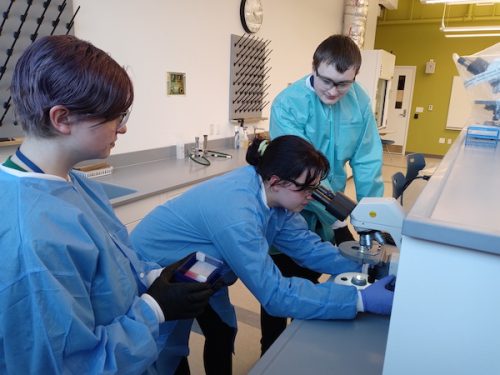
The Pittsfield team examines onion root tips halted mid-mitosis in preparation for their SSEP Mission 18 experiment.
Proposal Summary:
In our proposed experiment we will address the following question: Does microgravity affect chromosomal alignment on the metaphase plate during mitosis in onion root tip cells? We hypothesize that the onion root tip cells that will enter metaphase in microgravity will have more abnormalities in the equatorial chromosome alignment than the cells that will enter metaphase in Earth’s gravity. Alignment of chromosomes on the metaphase plate is important for ensuring that both daughter cells have the same number of chromosomes and are completely identical. Prior experiments have shown that microgravity affects the cytoskeleton of the cell, which is crucial for chromosomal alignment on the metaphase plate, and chromosomal segregation in anaphase. For this experiment, we will germinate onion seeds in microgravity on the International Space Station and in Earth’s gravity on the ground in the FME mini-lab. After 12 days of germinating we will fix the germinating onion roots with formalin. We will then stain the onion root tip cells and use light microscopy to compare the cells undergoing metaphase in microgravity to the cells undergoing metaphase in Earth’s gravity. The goal of the analysis is to see whether chromosomes stray away from the metaphase plate or if their equatorial alignment will remain unaffected. As human cells perform mitosis similarly to plant cells, this proposed experiment will be able to provide insight into the possible effects of long-term exposure to microgravity and other low gravity environments on humans and on the growth of plants in microgravity.
HONORABLE MENTION FINALIST:
The Impact Microgravity has on Ethylene Gas Production
Grade 14, Berkshire Community College
Principal Investigator: Rowan Boyer
Teacher Facilitator: Colin Wilson
Proposal Summary:
Seed germination has been discovered to be possible in space, but the microgravity environment in space prevents those plants from growing upwards as easily as they would on Earth. On a normal basis, auxin, a natural growth hormone, is found in ‘shoot and root’ tips of plants. This hormone divides cells and aids in stem and root growth. The auxin is what helps a plant’s roots to grow down with gravity and the stem to grow up against gravity. Auxin does not work alone though. Ethylene is a common hormone released by aging and germinating plants, especially fruit, in the form of a gas. The most common example of an ethylene producing plant is a banana turning brown. Ethylene holds many functions, some of which are, seed germination, shoot and root growth, and root development. Specifically, and most importantly, ethylene triggers the auxin’s signaling pathway and can keep root growth in check by exciting the auxin biosynthesis and managing the impact of its transport mechanisms. Increased ethylene gas production (which may be affected by low gravity) might be the key to more lush plant growth in space.
15. Oak Park, Michigan
Jump to Oak Park’s Community Profile
SELECTED FOR FLIGHT:
How Watermelon Germinates in Space Versus on Earth
Grade 5, Pepper Elementary School, Oak Park School District
Co-Principal Investigators: Raydein Balkcom, Aaliyah Bates, Ricardo Jackson, Kamdyn Lauderdale
Teacher Facilitator: Jill Burdick
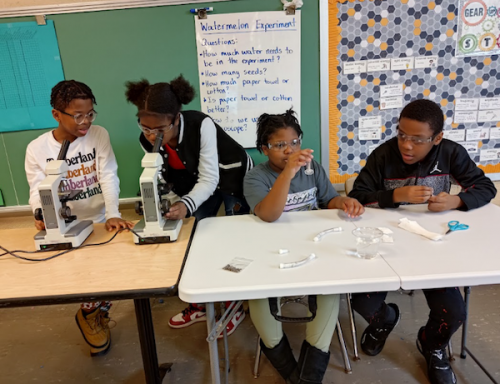
Pepper Elementary team utilizing microscopy to investigate and make observations on Citrullus lanatus (watermelon) seeds while preparing sample experiments to continue research.
Proposal Summary:
The investigation will show how watermelons will germinate on earth and in space. Because seeds need water and soil to grow, the mini-lab with two parts will be used to keep soil and water in one part and seeds in the other until the astronauts mix them together. The investigation will show if watermelon can germinate in a microgravity environment. Watermelon was chosen for this experiment because it has many health benefits. It helps people stay hydrated. Watermelon could reduce cancer risk. It may improve heart health, and it can help with weight management. Watermelon contains essential nutrients. Watermelon is a unique plant to grow because of how it grows on a vine.
HONORABLE MENTION FINALISTS:
Tardigrade Life Cycles on Earth and in Microgravity
Grade 5, Pepper Elementary School, Oak Park School District
Co-Principal Investigators: Carter Grimes, Lauryn Matthews, Jeremiah Purdue, Davi’on Sims
Teacher Facilitator: Jill Burdick
Proposal Summary:
The investigation will show how tardigrade eggs grow and develop in space and if the life cycle of tardigrades is changed in microgravity compared to on Earth. The eggs that stayed on Earth will be compared to the eggs that were sent to the International Space Station and experienced the microgravity environment. Because tardigrades are known to survive in extreme conditions, this experiment could help people understand how various living things could survive in space. Tardigrades can survive in a nearly dehydrated state. Scientists already know that adult tardigrades can survive in space. This experiment could grow understanding of tardigrade eggs and their survival and life cycle in space.
Germination of Corn in Space
Grade 5, Albert Einstein Elementary School, Oak Park School District
Co-Principal Investigators: Harmoni Harris, Erinjade Fuller, Ay’Mia Danforth, ChristieAnn Jennings, Mahlayia Washington
Teacher Facilitator: Senetra Ward
Proposal Summary:
The purpose of this experiment is to see what effects microgravity has on corn seed germination. The team learned microgravity is the “condition in which people and or objects appear to be weightless in space”. The team also learned that germination is when seeds develop or grow into new plants. Corn can be included as part of a person’s diet even for those who have diabetes because corn is said to be a good source of fiber. The reading also tells us that corn helps to lower blood pressure and is filled with many vitamins and minerals. The team’s curiosity about corn seed germination makes the team wonder if there was room on the ISS, could corn grow there because of the many different benefits the team read about.
16. Edina, Minnesota
Jump to Edina’s Community Profile
SELECTED FOR FLIGHT:
Does Gravity Affect the Germination Rate of Raspberry Seeds
Grade 5, Creek Valley Elementary School, Edina Public Schools
Co-Principal Investigators: Nithini Weerakkodi Arachchilage, Kaydence Chen, Fallon Smith, Marit Western
Teacher Facilitator: Cody Ellis
Proposal Summary:
We have decided to test the effect gravity has on raspberry germination. Raspberries have many benefits and positive effects on the human body like vitamins A, B6, C, E, and K. They also contain potassium, iron, and antioxidants, and help manage diabetes, improve heart health, and ease arthritis pain. Raspberries are easier to grow than other plants because they are fairly resistant to diseases and pests. If raspberries are able to germinate in microgravity, the astronauts on the ISS can benefit from its many nutrients. Our experiment is going to contain dirt (loam) and young seeds, water (spring water), and a growth inhibitor (abscisic acid). The growth inhibitor is going to stop the raspberries from germinating on the way down to Earth. We decided on loam because we researched and found that plants grow best in loam which is a mixture of sand, silt, and clay. We decided on young raspberry seeds because the age of the raspberry seeds significantly affected the germination rate. We also found that plants grow best with spring water or rain water. We decided on spring water because it is easier to buy. When the FME gets to the ISS the astronauts will unclamp clamp A and shake gently for 5 seconds to mix in the water from a separate compartment. Then 2 days before undocking the astronauts will open clamp B and shake gently to mix in the growth inhibitor.
HONORABLE MENTION FINALISTS:
Study of the Root Growth and Liquid Intake of a Chlorophytum Comosum Roots in Microgravity as Opposed to Chlorophytum Comosum in Earth’s Gravity
Grade 11, Edina High School, Edina Public Schools
Co-Principal Investigators: Léo García Temiño, William Teskey
Collaborator: John Fernandes
Teacher Facilitator: Jodi Ramerez
Proposal Summary:
This project will attempt to determine the difference in the speed of root growth of spider plants in microgravity as opposed to a spider plant on Earth as well as the difference in liquid. It is hypothesized that a lack of gravity and light will cause the roots of the spider plant in space to be longer than the roots of the spider plant on Earth, grow in several random directions and use more water and minerals than the spider plant on Earth. Spider plants produce a large amount of oxygen and can purify the air of toxins. This experiment will be very useful in learning the differences between how a spider plant grows in space and on Earth.
Growth of Typha Latifolia
Grade 8, Valley View Middle School, Edina Public Schools
Co-Principal Investigators: Evelyn Ge, Angela Huang
Teacher Facilitator: Christine Retzlaff
Proposal Summary:
This investigation aims to study the cattail’s capability to soak up water and the growth of rhizomes in microgravity compared to Earth. We hope to help NASA’s ambition of colonizing Mars. Once astronauts begin living on Mars, they need an efficient way of filtering water from harmful toxins. Typha Latifolia is the answer. Cattails can be used in all sorts of ways. They can be used as a biofuel to power spaceships and household items. It is also a calorie-rich plant that contains many useful minerals such as potassium and phosphorus. The gelatinous substance can be used in medicine and the leaves can be woven into chairs and baskets. This experiment will not only study the growth of a plant in microgravity, but it will also provide a possible alternate source of a filter and fuel for future Martians.
17. Albany, New York
Jump to Albany’s Community Profile
SELECTED FOR FLIGHT:
The Effects of a Microgravity Environment on the Growth of Mold on Strawberries
Grade 8, William S. Hackett Middle School, Albany City School District
Co-Principal Investigators: Permission to post names pending
Teacher Facilitator: Craig Ascher
Proposal Summary:
Mold causes many problems on Earth, including food spoilage and mold-borne diseases. NASA plans to send humans to live on the ISS, the Moon, and possibly Mars. Problems on Earth are magnified in space because of the complexity and the expense of space travel. Mold has been found in the HEPA filters on the ISS, suggesting potential mold-related problems. The goal of this experiment is to test the effects of a microgravity environment on the growth of mold. In identical experiments on Earth and the ISS Penicillium notatum will be grown on freeze-dried strawberries, a preserved food that will resist mold prior to the experiment. A mixture of water and penicillium notatum will be introduced to freeze-dried strawberries. After a period in which mold may grow, formalin will be introduced to kill and preserve the mold spores. The types and quantities of mold spores present in both experiments will be compared using PCR tests and fluorescent stain tests. It is expected that less mold will grow in a microgravity environment because mold has evolved to grow in the conditions on Earth. Microgravity may also disrupt the formation and spread of sporophores. It is anticipated that the same varieties of mold spores will grow in both the control and the experimental lab because the FME Mini-Labs will not be exposed to any outside contaminants. This basic science research will have applications for future space habitation, food preservation, the prevention of mold-borne diseases, and other problems associated with mold growth.
HONORABLE MENTION FINALISTS:
The Effect of Microgravity on the Germination of Spinacia oleracea
Grade 8, William S. Hackett Middle School, Albany City School District
Co-Principal Investigators: Permission to post names pending
Teacher Facilitator: Craig Ascher
Proposal Summary:
According to research, Spinach is one of the best and healthiest vegetables to eat. Spinach is exceedingly beneficial to your health as it can benefit eye health, reduce oxidative stress, helps prevent and reduce cancer cells, and reduce blood pressure levels. It also can cut the risk of anemia, curbs appetite, and boosts hydration as well as improves bone health. Can spinach germination be better if it happened in space? This research aims to find out more about the microgravity environment and to see how plants can function. The growth rate of this plant is to be determined. This experiment’s purpose is to see if the microgravity environment can change the germination and parts of the spinach. It is predicted that if spinach is germinated in a microgravity environment, then it will grow a larger amount. For our results, we expect for the experiment to be a success and hopefully grow taller. If it grew more, it would be useful for knowledge and making germination for spinach more efficient.This experiment will be set up the same on Earth and in space. The test tube would have 2 clamps with 3 cubic centimeters of loam soil, 5 spinach seeds, and 3 milliliters of water and 2.5 milliliters formalin. They would both be setup on Earth and in space for 5 weeks with everything constant besides the microgravity environment.
The Effect of Microgravity on the Growth of Radishes
Grade 8, William S. Hackett Middle School, Albany City School District
Co-Principal Investigators: Permission to post names pending
Teacher Facilitator: Craig Ascher
Proposal Summary:
What is expected to be found out by this experiment are the beneficial effects of radishes being grown in a microgravity environment. Lastly, it is expected to be found out if radishes would be beneficial for astronauts in hypothetical long-term spaceflight. Radishes (on Earth) lower the risk of heart disease. Also, the nutrients in a radish can help control blood pressure. Radishes are rich in antioxidants like vitamin C, and minerals like calcium and potassium. Radishes also protect cells from damage, burn body fat, as well as a few other things. Growing radishes would obviously be beneficial to Astronauts in the future, so this is why we chose them. The hypothesis of this experiment is that the radishes will produce more vitamins if grown in a microgravity environment. However, this hypothesis is baseless, due to a lack of prior research. This will be set up on earth by growing radishes at the same time as it is being done in space. The radish will be given the same care (or similar care) to the ones being grown in space. It would be beneficial to learn about this because it could be found out if they would be viable for humans to eat and grow in the future. For example, during long-term spaceflight, a lot of space would be taken up by food. Growing food, such as radishes, could help reduce that load.
18. Garden City, New York
Jump to Garden City’s Community Profile
SELECTED FOR FLIGHT:
The Effects of Microgravity on the Mass of Salvia hispanica L. (Chia Seeds) Abundant with Omega-3
Grade 7, Garden City Middle School, Garden City School District
Co-Principal Investigators: Anjali Motwani, Tanya Oza
Teacher Facilitator: Dr. Zaferiou
Proposal Summary:
The following experiment will investigate if microgravity will affect the growth of Salvia hispanica L. Chia seeds are rich in minerals, omega-3 fat, antioxidants, and fiber and also easy to prepare. Studies suggest that they have various health benefits, ranging from weight loss to a reduced risk of heart disease. The biggest benefit to astronauts would be to their skin, which is significantly affected by microgravity. The main purpose of this project is to understand if Chia seeds will be just as easy to grow in microgravity as they are on Earth. The knowledge of chia seeds reacting in microgravity will help people by significantly benefiting astronauts by helping their skin and hair stay healthy with Omega-3 that they would be able to access in Chia seeds grown on the space shuttle. If astronauts have easy access to Omega-3 in space, they would be able to prevent effects such as burning, itchy, dry, sensitive and thinning skin. Other skin problems, such as infections, delayed wound healing, and accelerated skin aging could also be prevented. Chia seeds are really good for protein. Because they’re a great source of omega-3 fatty acids, chia seeds promote a lower omega-6 to omega-3 ratio. A low ratio is associated with a lower risk of various chronic conditions — such as heart disease, cancer, and inflammatory diseases — and a lower risk of premature death. Chia seeds contain 19% protein — a similar amount to other seeds but more than most cereals and grains.
HONORABLE MENTION FINALISTS:
Effects of Microgravity on the Germination of Aloe Vera Seeds
Grade 7, Garden City Middle School, Garden City School District
Co-Principal Investigators: Benjamin Fuschillo, Molly McAlea, Riley McAlea, Ryan Wagner
Teacher Facilitator: Amanda DeRiso
Proposal Summary:
On January 1st, 1925, space became the world’s biggest mystery when technology made significant scientific breakthroughs. People have pondered this mystery for almost a century making little steps towards our first big leap in understanding the mystery of the universe. The moon landing by Neil Armstrong on July 20th, 1969 was humankind’s first attempt at reaching the stars. NASA is now ready to make another. We propose the following experiment to investigate if “Aloe Barbadensis Miller,” better known as aloe seeds can be grown in space. If in fact this is possible, this will forever change space exploration and travel. The gel or “meat” in aloe can produce several health benefits. These are necessities in space because they can provide a quick and easy source of nutrition which would benefit the astronauts. Aloe seeds also produce high amounts of oxygen in space. These seeds are ranked in the top 5 of all oxygen-producing plants. Aloe also provides a great source of medicinal benefits because it helps heal burns from radiation. This would be beneficial in space due to burns or radiation from the sun as well as unidentified objects in space. This will help to evaluate whether we can grow aloe seeds in space and if this is possible, how can we extrapolate the many benefits that aloe seeds can provide. We believe that we should grow aloe seeds in space to enhance the future of mankind, the future of science, and space exploration!
Effects of Microgravity on the Germination of Chamomile Seeds
Grade 7, Garden City Middle School, Garden City School District
Co-Principal Investigators: Audrey Donahue, Emilio Dumain, James Dunn, Evangeline Ring
Teacher Facilitator: Amanda DeRiso
Proposal Summary:
The following experiment will investigate if Chamomile seeds (Matricaria chamomilla) can grow in space conditions. The main purpose of this project is to understand how they will germinate in microgravity conditions. The knowledge of Chamomile seeds reacting in microgravity will help astronauts because they are a medicinal plant species that can help with stress, upset stomachs, nausea, heartburn, vomiting, and helps with better sleep quality. These are important traits because the astronauts need something to help them if they become ill in space. Being well rested is important because the circadian rhythm disrupts the mental and physical changes which makes it harder for people to sleep in space, so drinking Chamomile will help with that. Finally, Chamomile helps with your digestive system which can help in space because astronauts usually aren’t eating the regular foods that they would on earth. In sum, Chamomile seeds provide many health benefits that would be very helpful while in space.
19. Long Beach, New York
Jump to Long Beach’s Community Profile
SELECTED FOR FLIGHT:
The Effect of Microgravity on the Germination of Watercress Seeds
Grade 6, Long Beach Middle School, Long Beach Public Schools
Principal Investigator: Katrina Casey
Investigator: Jasmine Davidson-Smith
Collaborators: Claire Cristallo, Kaylee Cooper
Teacher Facilitators: Natasha Nurse, Elizabeth Chimienti, Dina Callahan
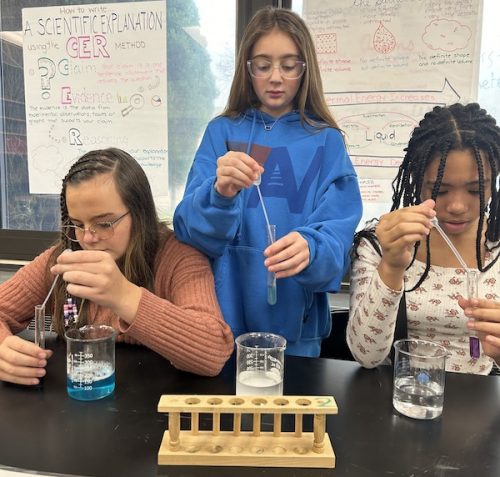
Long Beach, NY Student Researchers from left to right: Katrina Casey, Claire Cristallo, Jasmine Davidson-Smith (not pictured: Kaylee Cooper).
Proposal Summary:
The question our group is researching is “How does microgravity affect the germination of watercress seeds?” This question is important because cress seeds are incredibly beneficial. Watercress can help lower blood sugar, aid indigestion and constipation, promote heart health and reduce inflammation. And most importantly, watercress can grow easily in space, which is essential for astronauts on long space missions. A cress seed can sprout as quickly as up to 2-12 days. It also doesn’t need that much light. Through research it is shown that less gravity does not affect how fast the plant grows. (In one week it can grow 3 centimeters and it will also be ready to eat). Watercress growing fast can also help benefit if an astronaut gets constipation or indigestion, because there will not be a long wait for the plant to grow. The question is important because watercress seeds have many benefits. The team is using FME Type 3 to conduct the experiment. Distilled water will go in Volume 1, rockwool and watercress seeds will go in Volume 2, and Neutral Buffered Formalin will go in Volume 3.
HONORABLE MENTION FINALISTS:
The Effect of Microgravity On The Germination of a Green Bean Seed
Grade 6, Long Beach Middle School, Long Beach Public Schools
Principal Investigator: Jamie Banta
Collaborators: Savannah Barnes, Emerson LaPenna
Teacher Facilitators: Natasha Nurse, Elizabeth Chimienti, Dina Callahan
Proposal Summary:
The question the team is testing is, “How does microgravity affect the germination of the green bean seed?” This question is important because the team is experimenting how well green bean seeds grow in space and how it is nutritious to the astronauts living in a microgravity environment for a certain period of time. Green beans are packed with dietary fibers, which are very important for a human’s health as everyone needs nutrient-dense foods. The experiment in microgravity with green beans not only helps to understand growth in space but also explores potential as a valuable food source, offering both low calories and essential nutrients. The team is using Type 3 FME mini-lab to conduct the experiment. In volume one, 2 mL of distilled water will be poured. In volume two, 2 square centimeters of rockwool will be placed. 6 green bean seeds will be placed inside of volume two with the rockwool. Volume three will contain 1 mL of 10% Neutral Buffered Formalin (NBF.) On day one (A=0) the astronauts will initiate the interactions between volume 1 and volume 2 by unclamping clamp A and gently shaking for exactly 10 seconds. On day U-5 ( Five days before the FME is undocked, clamp B will be opened so the formalin is released. Shake for ten seconds to mix the NBF.
The Effect of Microgravity on the Germination of Nasturtium Seeds
Grade 6, Long Beach Middle School, Long Beach Public Schools
Principal Investigator: Danielle Steier
Investigator: Natalie Suazo
Collaborators: Palmer Gallo, Mya Torres
Teacher Facilitators: Natasha Nurse, Elizabeth Chimienti, Dina Callahan
Proposal Summary:
The question that the team is testing is how microgravity affects the germination of Nasturtium seeds. This question is important because both the leaves and petals of the nasturtium plant are packed with nutrition, containing high levels of vitamin C. It has the ability to improve the immune system, tackling sore throats, coughs, and colds, as well as bacterial and fungal infections. Also, Nasturtium seeds originate in South America, its natural habitat is the tropical or subtropical montane forests of the Andes mountains. Nasturtium seeds are considered a fruit, herb, vegetable, and a flower. In Long Beach Middle School, we have a greenhouse. We have already planted seeds in the greenhouse. Our team will be using the FME Lab type 3 to conduct the experiment in school and in space. In volume one, we will have two milliliters of distilled water. In volume two, there will be three cubic centimeters of rockwool and two nasturtium seeds. Lastly, in volume three, there will be two milliliters of 10% Neutral Buffered Formalin (NBF). The astronauts will interact with the sample on day 1 A=0 unclamp clamp A between volumes one and two and shake it lightly for 10 seconds. The next time the astronauts will interact with the sample is on day U-2 they will unclamp clamp B between volumes two and three and shake it lightly for 10 seconds. We decided on this timeline because on day one we would like the water to get involved with the plant.
20. North Tonawanda, New York
Jump to North Tonawanda’s Community Profile
SELECTED FOR FLIGHT:
The Crystallization of the Spores of Bacillus Thuringiensis in a Microgravity Environment
Grades 11-12, North Tonawanda High School, North Tonawanda City School District
Principal Investigator: Cailee Cinquino
Collaborators: Emma Clancy, Tavery Cater, Natalie Scheifla, Madeline DeVantier
Teacher Facilitator: Melissa Elliott
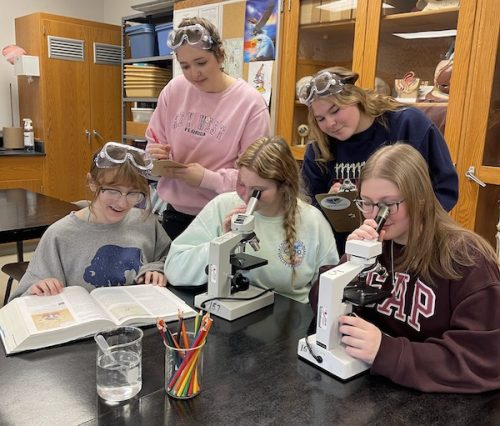
Our amazing group of young scientists as they refine their experiment and expand their knowledge about the behavior of bacteria Bacillus Thuringiensis.
Proposal Summary:
The bacterium Bacillus Thuringiensis, or Bt, produces crystalline proteins with toxins in aqueous environments. When inside the guts of insects, it damages and kills these insects, while making spores at an exponential rate, which grows the colonies of this renowned bacteria. This species is commonly used in pesticides, as this bacterium, in all strains, is only harmful to specific insects, proposing no risk to humans and animals alike. We are seeking to compare the bacterium of Bacillus Thuringiensis ability to manufacture its unique crystalline toxins and spores in Microgravity, compared to its abilities to produce its toxin under Earth’s gravity. In our experiment, we plan to culture Bacillus Thuringiensis when in Microgravity to call into question if this bacterium can continue to function similarly as it would on Earth. We believe this experiment will facilitate the gain of data and knowledge for the future, to put forth the idea of growing crops and the beginnings of agriculture under microgravity in space, as the bacteria that follows the crops into space is just as important as the agriculture themselves. In addition, through gene manipulation of agricultural crops, our crops now also make the same crystals that Bacillus Thuringiensis makes. We seek to understand if the crystals will be made in the same amount in microgravity as on Earth.
HONORABLE MENTION FINALISTS:
The Effect of Microgravity on the Development of Artemia salina
Grade 7, North Tonawanda Middle School, North Tonawanda City School District
Co-Principal Investigators: Zoe Link, Emma Turk
Investigator: Natalie Lisinski
Teacher Facilitators: Kelsey Gedra, Janet DeCicco
Proposal Summary:
Our investigation will seek to send Artemia Salina to space so we can observe their embryo development in microgravity and compare it to those that were developed on Earth with the normal amount of gravity. Our questions include things such as will the eggs hatch? If they do hatch, will they have defects? The eggs normally need to stay in an upright position to be able to develop without deformities, so we suspect that the shrimp will develop slight defects (such as tail kinks, smaller in size etc.) due to their eggs being developed in a microgravity environment. First, we will inspect how brine shrimp would normally be hatched, (average size, normal kinks found in them, how common these defects are, etc.). Having a group on Earth and in space we will wait for both groups to hatch. Giving both groups three days to grow without food, and once those three days are over, we will humanely kill them using isopropyl alcohol. Once the microgravity group has been returned to Earth, both groups will be observed. They will be checked for defects that would have impacted their anatomy and behavior. We, expect the eggs hatched on earth to develop normally, with limited defects. With the microgravity group, we expect elevated defect levels. Our goal is to figure out if these creatures will be able to properly develop, so that in the future we will better understand what type of animal life we will be able to properly raise in space.
Will Compost Decompose in Microgravity
Grade 6, North Tonawanda Intermediate School, North Tonawanda City School District
Co-Principal Investigators: Andrew O’Sullivan, Xavier Deschamps
Co-Investigators: Everett Zachritz, James White
Teacher Facilitator: Chelsea Moore
Proposal Summary:
Will compost decompose in microgravity? Compost in space would be really important if we want to colonize on different planets. For example, we eat a lot of fruits and vegetables. We can’t just throw organic matter out when we’re all done with it. The reason why we can’t throw out organic matter is that we have to cut down on waste. So we have to learn if fruits and vegetables can be composted in microgravity. Another example is that if we want to avoid making giant accumulations of trash and have it float off into space, then we have to figure out if composting works in space.
21. Red Hook, New York
Jump to Red Hook’s Community Profile
SELECTED FOR FLIGHT:
The Effect of Microgravity on the Hatching Rate of Rotifers
Grade 11, Red Hook High School, Red Hook Central School District
Co-Principal Investigators: Giacomo Buitoni, Ava Hubner, Lotta Pflaum, Emmy Nelson-Madore
Teacher Facilitator: Deborah Beam
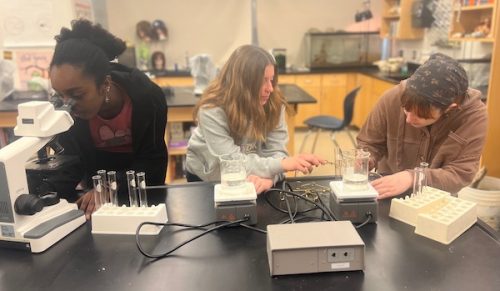
Pictured from left to right are Lotta Pflaum, Emmy Nelson- Madore, Ava Hubner; not pictured Giacomo Buitoni.
Proposal Summary:
The goal of the experiment is to determine how Rotifers will reproduce and develop in microgravity. The investigators will compare how the zooplankton grow under the effects of microgravity with how they develop under Earth’s gravity. The investigators hypothesize that Rotifers will reproduce and develop more rapidly under microgravity than they will on Earth. On both Earth and the ISS, equal samples of Rotifer eggs will be freeze dried prior to the start of the experiment. They will be rehydrated in freshwater. A fixative will be combined with the rehydrated Rotifers after a few days. Then, the hatching of the plankton on the ISS will be compared with that of the plankton on Earth. The goal of this experiment is to determine the effect, if any, of microgravity on the hatching rate of Rotifers. The results of the experiments could be used in waste management of fresh water, as these organisms can be used to prevent clouds of waste in water.
HONORABLE MENTION FINALISTS:
Comparing the Growth of Pleurotus osreatus Spores in a Microgravity Environment
Grade 11, Red Hook High School, Red Hook Central School District
Co-Principal Investigators: Eve Hayes, Louisa Zelek
Co-Investigators: Rosa Hagan, Kaitlin Murphy
Teacher Facilitator: Deborah Beam
Proposal Summary:
For our SSEP project, we want to answer the question of: How does a micro gravity environment affect the spore growth of the Pleurotus osreatus? We look to compare the spore growth of the mycelium in Earth’s regular 9.807m/s² of gravity and the growth in a microgravitational environment. The average size of the Pleurotus osreatus on Earth around 2-30 cm in size. When the spores are sent into microgravity conditions we would like to measure, how long they will grow, how the mass differs from that of the spores grown on Earth’s gravity to the, and how they will adapt to the new environment and what we can learn from cultivating spores in a microgravitational environment. As well as answer these questions for our group, this experiment will provide us with insight into horticulture in microgravity conditions, as well as help us gain a deeper understanding of terrestrial mycology. Recently there has been a new understanding of human’s relationships with fungi, and we hope to expand this knowledge by discovering new information about the behavior of fungi in microgravity. To create a “goldilocks” environment for our spores being sent into space we plan to send them with a living environment of boiled cardboard and wheat to sustain their growth, they will be kept in their ideal temperature to be sure that they are able to thrive. When the spores return to Earth, we will be able to compare the “space spores” to our control group that have been growing in Earth’s gravity.
How Hemoglobin Levels are Affected by Microgravity
Grade 9, Red Hook High School, Red Hook Central School District
Co-Principal Investigators: Violet McMillen, Ada Wilson
Co-Investigators: Sadie Bardfield, Nola McCann
Teacher Facilitator: Katie Whittaker
Proposal Summary:
This investigation will explore how microgravity affects the hemoglobin levels of a blood sample. Hemoglobin is a protein found in red blood cells that transports oxygen around the body. Hemoglobin levels in blood can be measured to ensure the body is receiving an appropriate amount of oxygen and is not suffering from conditions such as anemia. This experiment will help investigate the effects of microgravity on the human body, which could potentially help further the safety of astronauts in space and the development of medicine.
22. Grand Forks, North Dakota
Jump to Grand Forks’ Community Profile
SELECTED FOR FLIGHT:
The Effects of Rhizobia Enriched Soil on the Growth of Phaseolus Vulgaris (Black Beans) in Microgravity
Grades 14-15, University of North Dakota
Co-Principal Investigators: Peter Gauthier, Christopher Erickson, Colin Hoff
Teacher Facilitator: Keith Crisman
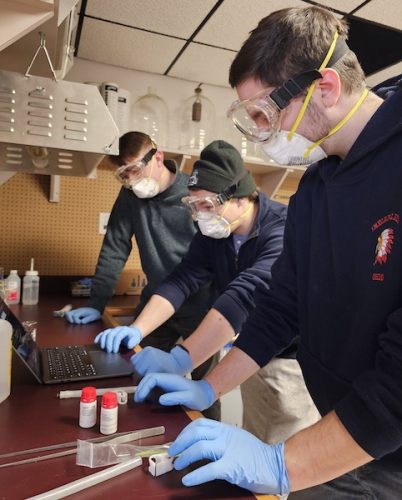
The Space Beans Crew looking over their data during the first run of their experiment for SSEP in the lab. Results are looking good!
Proposal Summary:
This investigation will determine the effects that microgravity has on the ability of Rhizobia bacteria strains to affect Phaseolus Vulagris sprouting. The goal is to determine whether or not growth in microgravity is not only possible but also sustainable for future endeavors in space exploration. The ability to sprout and grow plants quickly in a microgravity environment is paramount to ensure the ability of the crew to remain healthy and fed throughout long journeys.
HONORABLE MENTION FINALISTS:
Evaluating the Efficacy of Clarithromycin in Treating Anaerobic Bacteria Resulting from Aspiration in Microgravity
Grades 13 and 15, University of North Dakota
Co-Principal Investigators: Ryan Branconier, Camrin Cass, Shelton Munnerlyn
Teacher Facilitator: Keith Crisman
Proposal Summary:
In microgravity environments astronauts do not have the constant force of gravity to keep their stomach contents suppressed. Thus, acid reflux is a common occurrence in space flight which exponentially increases the risk of pneumonia aspiration in astronauts as bacteria of the stomach can enter the respiratory system. One of the most common and harmful bacteria found in the lining of the stomach and intestines is Helicobacter Pylori, which is primarily responsible for ulcers and gastritis. The objective of our proposed experiment is to assess the effectiveness of Clarithromycin in combating a simulated infection of Helicobacter Pylori in lung tissue under microgravity conditions. Once Clarithromycin is exposed to Helicobacter Pylori the measure of interaction will be to assess how many Helicobacter Pylori remain alive after exposure to Clarithromycin. This crucial data point will provide insight into the antibiotic’s ability to combat this particular bacterium in a simulated microgravity environment. By conducting this experiment, it is the hope that NASA will gain a useful data set on the efficacy of Clarithromycin to combat gastrointestinal sourced bacteria in lung infections.
Ceftazidime, Avibactam, Metronidazole & E. Coli: Investigating the Effects of Microgravity on Appendicitis Antibiotics
Grades 13 and 16, University of North Dakota
Co-Principal Investigators: Kellan Daley, Clara Green, Ava Thrawl
Teacher Facilitator: Keith Crisman
Proposal Summary:
Despite their best efforts, scientists around the world have not managed to eradicate appendicitis. This condition is signified by the appendix becoming inflamed. If left untreated, the appendix can rupture, which can be fatal. Appendicitis can be caused by obstruction of the appendix, bacterial infection, or viral infection. Short of removing the appendix, this condition isn’t preventable—and removing the appendix has its own complications. Modern goals of global space agencies include expanding the reach of human spaceflight, which requires effective medical treatment in microgravity. This need expands as space agencies develop and launch missions with destinations farther away from Earth and with larger crews. Medical treatments must be tested in the unique environment of space. Ceftazidime, avibactam, and metronidazole are antibiotics used for appendicitis treatment. Typically, appendicitis is treated with laparoscopic appendectomy. However, surgery in microgravity is difficult and high-risk. Antibiotic-only treatment for uncomplicated appendicitis has been studied; of particular interest is antibiotic-only treatment in remote locations as a first aid measure allowing the patient time to be transported to a hospital, similar to spaceflight conditions. However, the efficacy of these antibiotics in microgravity must be studied prior to their need. The investigation will determine their efficacy and predict their fit for appendicitis treatment in microgravity.
23. Athens, Ohio
Jump to Athens’ Community Profile
SELECTED FOR FLIGHT:
Effect of Spaceflight-Adapted Bacteria on Plant Growth and Resilience in Microgravity
Grades 14-16, Ohio University
Co-Principal Investigators: Michael Lane, Nathan Smith, Victoria Swiler
Teacher Facilitator: Nicholas Whitticar
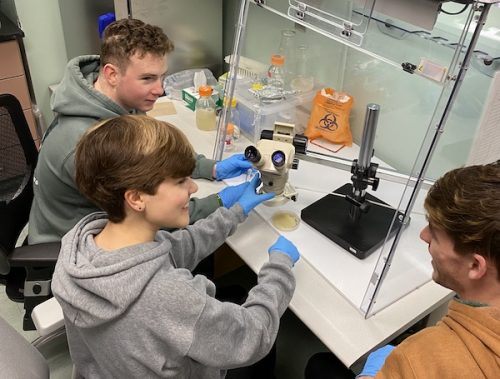
Ohio University’s Mission 18 Team (Michael Lane, Victoria Swiler and Nathan Smith) examining the growth of Sphingomonas sanguinis, an ISS-derived bacteria.
Proposal Summary:
Manned space travel and colonization of the Moon, Mars, and beyond requires growing plants for food, nutrients, and gas exchange. One method of promoting plant growth in stressful environments, such as microgravity, is by inoculating them with beneficial bacteria. Novel strains of Sphingomonas sanguinis have been identified on the International Space Station (ISS) that contain plant growth-promoting genes, but their effects on plants have not been tested. Therefore, the proposed experiment will determine if S. sanguinis promotes resilience to microgravity in the model plant Arabidopsis thaliana. Arabidopsis will be grown with and without S. sanguinis in microgravity and on Earth, creating four experimental conditions. In preliminary experiments, S. sanguinis from the ISS demonstrated benefits to plant growth within the mini-laboratory device. To determine if S. sanguinis is beneficial to plant growth under the unique stresses of microgravity, a spaceflight experiment is necessary. Arabidopsis and S. sanguinis will be grown on the ISS and Earth and fixed with RNAlater to halt growth and preserve the RNA. RNA expression for plant and bacterial genes related to bacterial detection, growth, and virulence factors will be quantified with qPCR to reveal the details of the plant-bacteria interaction. Root and shoot length, germination, and bacterial growth will also be measured. All data will undergo statistical analysis to test the hypothesis that S. sanguinis will benefit Arabidopsis resilience in spaceflight by reducing microgravity-induced stress. With this knowledge, we become one step closer to growing crops that thrive in microgravity and allowing humanity to explore new frontiers.
HONORABLE MENTION FINALISTS:
Effect of Microgravity on growth of Lemna minor: a Promising Space Food
Grades 15-16, Ohio University
Co-Principal Investigators: Lara Fogwell, Cat Gavin, Jake Magula
Teacher Facilitator: Remington Burwell
Proposal Summary:
Duckweeds belong to the monocotyledon family Lemnaceae, a family of floating aquatic plants. One species in the Lemnaceae family, Lemna minor, is a relatively simple plant to cultivate due to its small size and rapid growth rate. Lemna minor has been a target of recent research as a bioenergy crop for its great potential to accumulate starch, fight radiation damage, and purify water, as well as its potential for feeding personnel in space travel. Recent research conducted on duckweeds in microgravity environments has yielded promising results for its potential as a crop in spaceflight. Results from this research have indicated that duckweeds in microgravity may increase in starch content as well as growth rate. This implies that duckweed cultivated in microgravity could outperform duckweed grown in Earth gravity. This experiment will investigate the effects of spaceflight on Lemna minor’s germination, and how this species can grow and adapt in microgravity in a limited, enclosed space. When exposed to microgravity conditions aboard the ISS, Lemna minor is hypothesized to have germination success rates comparable to Earth gravity conditions. The growth rate of duckweed in microgravity is expected to be higher than that observed in Earth gravity. Additionally, it is anticipated that the starch content in Lemna minor grown in microgravity will increase compared to Lemna minor grown in Earth gravity, as microgravity conditions may potentially enhance starch accumulation in the plants.
The Effects of Microgravity on Tocopherol Content in Radish Seed Germination
Grades 14-16, Ohio University
Principal Investigator: Lindsay Robertson
Co-Investigators: Cierra Willis, Emily Skipworth, Sadie Lamerson
Teacher Facilitator: Sarah Wyatt
Proposal Summary:
This investigation will expand on current scientific understanding of the physiological effects of microgravity on microgreen germination. Radish seeds germinated in microgravity and ground level control conditions will be analyzed for vitamin E’s various chemical forms. Naturally occurring vitamin E has four tocopherol variations, γ-tocopherol, α-tocopherol, δ-tocopherol, and β-tocopherol. Focus will be placed on α-tocopherol content, the currently recognized most important form of vitamin E to human nutrition. The biosynthetic pathway in plants for α-tocopherol production is well studied and uses γ-tocopherol as a precursor. Research in ground level conditions demonstrates radish seeds’ dominant tocopherol form to be γ-tocopherol, and α-tocopherol increases throughout germination. In this investigation, post-germination tocopherol content will be compared among microgravity and control conditions. Differences in α-tocopherol content will be analyzed to determine if gravity has an influence on the synthesis of human bioavailable vitamin E in early plant growth. Radishes are a contending crop for space botany research due to their nutritional properties, efficient maturity rate, and minimal maintenance requirements. The expectation is that agricultural research in microgravity conditions will allow supplementation of fresh foods and enhanced flavor to astronauts’ diets during space exploration. It is then necessary to establish the nutritional value of crops grown in microgravity for realistic expectations of the supplementation these crops may provide. Understanding vitamin E production is an essential component to understanding the nutritional profiles of space grown crops.
24. Kent, Ohio
Jump to Kent’s Community Profile
SELECTED FOR FLIGHT:
The Effects of Microgravity On Pisum Sativum Roots
Grades 13 and 15, Kent State University
Co-Principal Investigators: Jonathan King, Mackenzie Guy
Teacher Facilitator: Syed Arbab Mohd Shihab
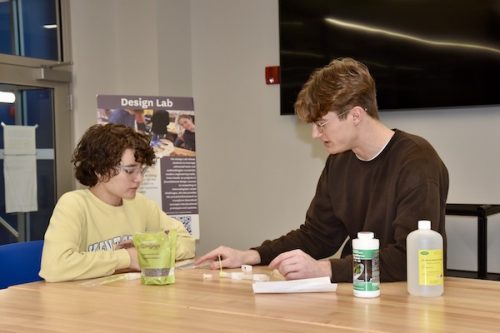
Kent State University’s co-principal investigators, Mackenzie Guy and Jonathan King from the College of Aeronautics and Engineering, immersed in their experiment development in the Design Lab located in the Aeronautics and Engineering Building.
Proposal Summary:
The investigation will explore the hydroponic-based microgreen growth of Pisum Sativum (green pea) roots and how this growth is affected by a microgravity environment. This experiment will focus on how successful the Pisum Sativum is in thriving in a microgravity environment and if root growth can be controlled by providing a supplementary medium for the microgreens to take root into. While microgreen growth in microgravity has been researched previously, root growth manipulation has less published research. If the investigation is successful, it will reinforce the reliability of hydroponic microgreen growth in microgravity environments and will establish a way to support the root systems of plants grown hydroponically in microgravity and consequently improve the efficiency of microgreen growth. The proposed experiment is crucial to the advancement of space exploration, because while living conditions become increasingly adverse as humanity ventures further from Earth, the need for easy-to-replicate systems that support life grows immensely. These innovations are greatly beneficial, as they would provide a renewable source of nutrients for astronauts in space, reducing the need for transport of resources from the Earth’s surface. By reducing the need for the transport of resources, less pollution will occur from launch pollutants like fumes, and astronauts will be able to survive for longer outside of Earth’s atmosphere. Additionally, it will act as a baseline for more complex experiments related to hydroponic root management, allowing for advanced research to build from the concepts demonstrated in the proposed experiment.
HONORABLE MENTION FINALIST:
Purification of Heavy Metals in Water by Red Algae
Grades 13-15, Kent State University
Co-Principal Investigators: Turaba Rahman, Jaylund Rose, Benjamin Windt
Teacher Facilitator: Hamza Balci
Proposal Summary:
Water purification is a crucial concern in space environments, and understanding how Rhodophyta, or red algae, can contribute to this process holds remarkable importance. Red algae exhibit special characteristics, such as their efficient photosynthetic process in low-light conditions, ability to purify water of metals such as lead and iron, and adaptability in extreme conditions, making them an ideal candidate for this study. This investigation will assess the effectiveness of red algae in removing heavy metals from water, a fundamental requirement for sustainable human habitation in space. By measuring removal of heavy metals in the water in the presence of red algae, the study will shed light on its potential role in mitigating water contamination in space habitats. Furthermore, the experiment will delve into the growth dynamics of red algae under microgravity conditions. Understanding how these organisms adapt and develop in space is essential not only for sustaining life during extended missions but also for advancing our knowledge of biological processes in extraterrestrial environments. The insights gained from this experiment could have far-reaching implications for space exploration and have practical applications on Earth as well. Red algae’s ability to purify water and adapt to microgravity conditions may enhance our understanding of aquatic ecosystems. Moreover, this research could lead to innovative solutions for water purification and environmental remediation back on Earth, where heavy metal contamination is a global concern.
25. Pickerington, Ohio
Jump to Pickerington’s Community Profile
SELECTED FOR FLIGHT:
Effects of Microgravity on Liquid I.V. Hydration Multiplier
Grade 12, Pickerington High School North, Pickerington Local School District
Co-Principal Investigators: Macy Erickson, Dorian Hamilton
Teacher Facilitator: Daniel McCullough
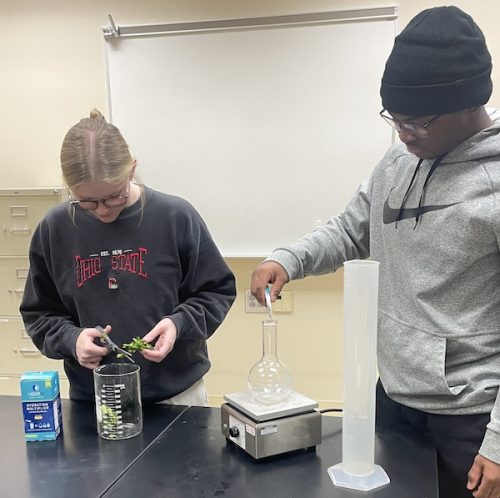
Macy Erickson and Dorian Hamilton, seniors at Pickerington High School North, preparing Elodea samples and hydration solution for their research experiment trails.
Proposal Summary:
This experiment is twofold: Part One will determine how well Liquid I.V. Hydration Multiplier powder mixes in water while microgravity is in effect, and Part Two will investigate how cell hydration levels in microgravity will compare to cell hydration levels on Earth. Liquid I.V. is a type of hydration substance that uses cellular transport technology (CTT) to hydrate faster than just water alone due to multiple modes of transportation that enhance water absorption into the body. Their products use Smart Hydration Technology to hydrate better than water alone through multiple modes of transport. This technology is done through the use of CTT, made up of five different substances: sodium, potassium, glucose, water, and micronutrients. With this information, the research team will test how efficiently the Liquid I.V. product combines with water in microgravity. Liquid I.V. often emphasizes a specific ratio of electrolytes and glucose to create an osmotic force that enhances water absorption at the cellular level, potentially promoting faster and more effective hydration. These substances will allow water to enter the body faster, making cells more hydrated to recover from strenuous activity or exercise. If the results of this experiment show that the solution can function in microgravity the same as it would on Earth, this hydration substance would support astronauts to keep them hydrated due to the limited amounts of water they have in space.
HONORABLE MENTION FINALISTS:
Mold Saves the Day!
Grade 9, Pickerington High School North, Pickerington Local School District
Co-Principal Investigators: Hali Mohamed, Sage Shriver
Teacher Facilitators: Brian Ptinty, Carla Fultz
Proposal Summary:
The goal of the research project is to investigate whether penicillium is able to thrive in microgravity as a powerful antibiotic like it does on Earth. This research is important because space is known to cause certain skin problems, and if that does happen penicillium creates an antibiotic called penicillin that if used correctly is able to help treat skin issues. Microgravity is known to increase skin sensitivity, increase susceptibility for skin infections and delay the healing process of wounds. There have also been some cases and reports of rashes developing during space flights. Penicillium is also Therefore the student researchers believe this project could be a new breaking point for modern science and could lead to new discoveries. If this experiment goes well it could open doors to similar experiments like this for the future.
The Effects of Oregano Oil on Bacteria in Microgravity
Grade 6, Toll Gate Middle School, Pickerington Local School District
Co-Principal Investigators: Bhumika Dahal, Isaac Little, Liam Potts
Teacher Facilitators: Kristen Ramsdale, Anna Meyer
Proposal Summary:
The purpose of this experiment is to explore the effects of how oregano oil disinfects in microgravity compared to Earth. Comparing the system in a microgravity environment and on Earth will help us understand if oregano oil can naturally kill bacteria in space. This research is necessary because it can help scientists and astronauts on the International Space Station by preventing disease so they will be in less danger in space since they are far from the nearest doctor or hospital. Usually, they would be in big trouble if they are sick, but having a safe way to prevent bacterial growth can help keep them safe. The experiment this group is proposing will address the question: How does oregano oil disinfect in microgravity? Based on our research of similar experiments, the hypothesis is that oregano oil can reduce or reverse the effects of bacterial and viral infections. If correct, the experiment will benefit the astronauts on the International Space Station because it will help them with bacterial infections that generally might make them ill.
26. Pittsburgh, Pennsylvania – CCAC
Jump to Pittsburgh’s Community Profile
SELECTED FOR FLIGHT:
Effect of Microgravity on the Enzymatic Degradation of Polyurethane by Penicillium chrysogenum
Grades 13-14, Community College of Allegheny County
Co-Principal Investigators: Maya Burns, Faith Dunn
Collaborator: Connor McDonagh
Teacher Facilitators: Patricia Donehue, Anne Duffy
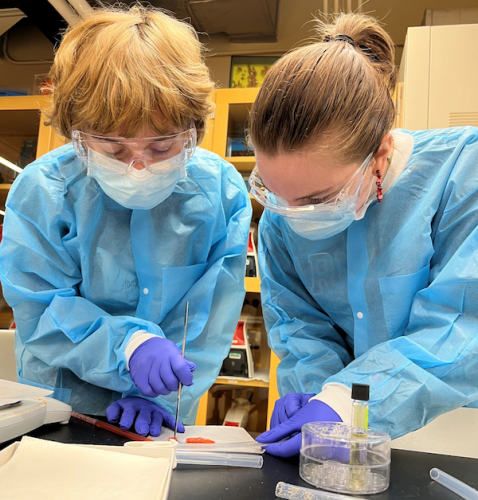
Maya Burns (left) and Faith Dunn (right) testing a mold to create an agar cylinder for assessment of fungal polyurethane degradation within the mini-lab.
Proposal Summary:
Every year, around 360 million tons of the common industrial and consumer use of the plastic, polyurethane (PUR), is produced; 80% will be reduced to pollution. Landfills hold a tremendous amount of plastic waste, and pollute both land and water; some plastics are even incinerated and contribute to air pollution. The scientific community has seen an increased interest in attending to plastic pollution through several avenues, including the reduction of already existing plastic pollution that, without intervention, is likely to remain indefinitely. Several organisms have been found to be capable of reducing the plastic polyurethane into smaller, recyclable chemical compounds. This experiment will test how microgravity affects the fungus Penicillium chrysogenum’s biodegredative enzymes ability to degrade a sample of polyester-polyurethane. This information can be used to facilitate the transition to circular production/waste economies, both on Earth and in space exploration endeavors.
HONORABLE MENTION FINALISTS:
Microgravity-induced Effects on the Behavior and Morphology of Moon Jellyfish and their Epigenetic Inheritance
Grade 13, Community College of Allegheny County
Co-Principal Investigators: Bailey Krimm, Grace Lowe, Sara Turner
Teacher Facilitator: Francis Cartieri
Proposal Summary:
Similar to the human ear, moon jellyfish have a series of hairs in the undercarriage of their bell called gravireceptors that regulate proprioception and kinesthesia. As part of the groundbreaking Spacelab Life Sciences 1 Experiment in 1991, moon jellyfish that were grown from polyps exposed to microgravity showed signs of vertigo due to irregular pulsations of their gravireceptors reaching full term. Since then, many advancements have been made in both the genetic community as well as space research and biological testing capabilities. In the proposed investigation, four male and four female moon jellyfish polyps will be sent into microgravity and brought back to be grown alongside a control group of nonexposed polyps living in mirrored conditions. Their path tracing, stride length, jet propulsion, as well as simple qualitative observation of behavior will be measured to assess any effect on the function of gravireceptors. In order to push this experiment further for an epigenetic purpose, the jellyfish will be encouraged to breed, and any possible epigenetic effects on the F1 generation will be tested. The methylation levels of the F1 generation will also be tested, as this is the most effective way to test the epigenetic effects on an organism. The results of this research project will give the scientific community a better theoretical understanding of the frontal and epigenetic effects of space travel on humans, as well as other organisms.
Design and Testing of a Novel Multi-axis Microgravity Simulator vs. the Real Thing: a Test Case using the Black Mold, K. chersonesos
Grade 13, Community College of Allegheny County
Co-Principal Investigators: Ajani Adegbindin, Matt Koepfer, Mamadou N’diaye, Anene Otubelu, Aaron Stevens
Teacher Facilitator: Francis Cartieri
Proposal Summary:
Microgravity is an important factor influencing microbial life in space environments, a condition in which the gravity level is almost zero but not neutralized. Due to the technological and logistical hurdles linked to studies of microgravity in space, different methods have been developed to simulate microgravity and analyze microbial responses. Hence, studying the reaction of black fungi to microgravity holds potential for the elucidation of the molecular basis of tolerance in extremotolerant and extremophilic fungi, and can also contribute to unearthing the biological uniqueness of these species and their adaptability to space conditions. Unfortunately, black fungi have only been studied under simulated microgravity. There are numerous constraints and issues with existing microgravity simulators (i.e. clinostats), most importantly, they are cost-prohibitive. We propose to design and build a 3-axis clinostat that meets or exceeds the standards of existing 2-axis clinostats, and to test our design by comparing the simulated results of black fungi grown on our clinostat with samples of black fungi grown on the ISS and a ground control under normal gravity conditions. A secondary goal of our project is to provide a testing platform for future SSEP experiments, be they at CCAC or other institutions. A major issue facing many projects is how to assess the likelihood that microgravity will affect a given organic material or process. We aim to prototype and test a low cost, open source microgravity simulator for use in preliminary feasibility studies for future SSEP missions.
27. Columbia, South Carolina
Jump to Columbia’s Community Profile
SELECTED FOR FLIGHT:
Gravitational Effects on Calcium Oxalate (CaOx) Regulation in Edible Greens
Grades 13-14, Midlands Technical College
Co-Principal Investigators: Craig Elliot, Robert Ferguson, Emmi Rosario, Will Turner
Teacher Facilitator: Jordi Fernandez
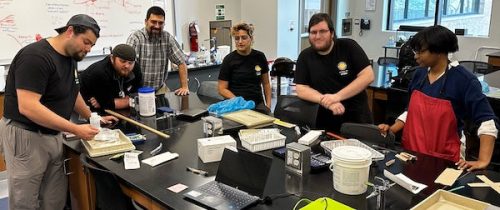
The Midlands Tech experimental flight team and faculty advisors are preparing their materials to be autoclaved for the next round of tests.
Proposal Summary:
This investigation concerns the production of Calcium Oxalate (CaOx) in edible greens. The ability to cultivate greens in space is an important idea that could lead to self-sufficiency in terms of providing some extra food while in space. Plants, including edible greens, produce CaOx primarily for calcium regulation. However, these crystals have been known to aid in the production of kidney stones, which is something that astronauts struggle within greater numbers than the average person on Earth. The experiment hopes to find whether microgravity will affect the edible greens’ ability to produce CaOx. Specifically, whether the micro gravity will cause the plants to produce more and larger calcium oxalate crystals. As well as further research that has been assessed of CaOx in vitro during a micro gravity environment.
HONORABLE MENTION FINALISTS:
Feasibility of In-situ Derived Concrete in a Microgravity Environment with Regolith
Grades 13-14, Midlands Technical College
Co-Principal Investigators: Ethan Collins, Lucas Leon
Teacher Facilitator: Dr. Eric Bothur
Proposal Summary:
Concrete is the most widely used construction substance on earth, which leads to it being the second most used substance overall. Being the second most used substance on earth holds the implication that such a material will continue to be extremely useful for humanity in the future. The regolith (dirt) that makes up the surface of the moon contains concentrations of up to and exceeding 50% source chemical of that in cement. If we are able to extract these materials, we may be able to create a concrete of similar or greater strength than the concrete we use on earth. Such a material would be extremely useful off the planet, and primarily on the moon. It could be used to construct infrastructure that would be necessary for a sustained presence of humans on the moon. Our experiment hopes to demonstrate the feasibility of the use of concrete in environments with gravity dissimilar to earth. By launching a sample to the ISS, we can gather information on how gravity affects the characteristics of concrete and gather data to determine the feasibility of using such an important material for the expansion and exploration of humans on other celestial bodies.
The Effects of Microgravity on Toxic Secondary Metabolite in Edible Fungi
Grades 13-14, Midlands Technical College
Co-Principal Investigators: Craig Jacob Elliott, Robert Ferguson, Emmi Rosario, Will Turner
Teacher Facilitator: Jordi Fernandez
Proposal Summary:
Aspergillus oryzae, commonly known as kōji mold, is used worldwide for food production. A. oryzae is relatively harmless and safe for human consumption. A. oryzae is very closely related to two other molds known as Aspergillus flavus and Aspergillus parasiticus, two highly toxic molds. This is because A. flavus and A. parasiticus produce a highly carcinogenic compound known as aflatoxin. It is not currently known if A. oryzae is incapable of producing aflatoxin or not. The investigation is set to see if a sample of A. oryzae that is grown in a microgravity environment will start to produce aflatoxin. This is important to know for food growth in a microgravity environment going forward to keep interstellar food production safe.
28. Arlington, Texas
Jump to Arlington’s Community Profile
SELECTED FOR FLIGHT:
Germination of Pisum sativum in Microgravity
Grades 10-11, James Martin High School, Arlington Independent School District
Co-Principal Investigators: Camilo Henao, Grant Hester
Co-Investigators: Ethan Chen, Kaleb Kim, Sofia Ochoa
Teacher Facilitator: Krassimira Hansard
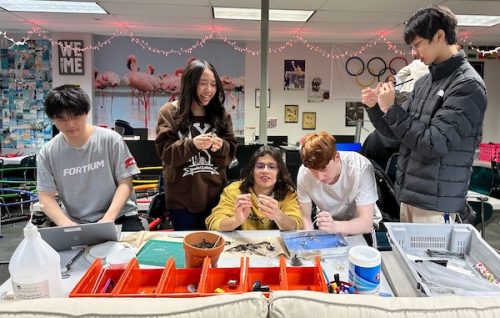
10th graders Kaleb Kim, Camilo Henao, Grant Hester, and Ethan Chen and 11th grader Sophia Lin Ochoa streamline germination parameters for their SSEP Mission 18 flight experiment.
Proposal Summary:
This experiment will measure how microgravity affects the germination of Pisum sativum, or more commonly known as pea shoots. Peas are very nutrient-dense and are full of carotenes – strong antioxidants that protect cells from damage. By measuring the germination and formation of the pea shoots, this experiment could be able to determine how microgravity changes carotenoids for any further experimentation. Carotenoids are crucial to human nutritional health. They contain β-carotene and α-carotene, dietary precursors of vitamin A, and are essential for the eyes and immune system. They are also a good source of dietary fiber, contain copious amounts of vitamins C, E, and A, and consist of antioxidants that help decrease the risk of various chronic diseases including cancer and cardiovascular diseases. Pea shoots can assist in the health of astronauts in space as they experience space anemia or decreased production of red blood cells. Due to the rapid growth of pea shoots, this experiment will be able to measure nearly the entire growth of a pea shoot, from a dry pea to a nearly fully grown pea shoot ready to harvest.
HONORABLE MENTION FINALISTS:
How is the Strength of Carbon Fiber Affected in Space?
Grades 10-12, James Martin High School, Arlington Independent School District
Co-Principal Investigators: Rachel Fox, Catalina Gonzalez, Tammy Lin, Christy Nguyen, Mayu Wilderman
Collaborator: Sebastian Rodriguez
Teacher Facilitator: Krassimira Hansard
Proposal Summary:
In the experiment provided, researchers aim to investigate the durability of carbon fiber following long-term submergence in a microgravitational environment. Carbon fiber was chosen due to its properties: high stiffness, tensile strength, chemical resistance, temperature tolerance, low thermal expansion, and weight. The submerging variable, distilled water, was chosen because it is the foundation that constitutes the majority of weather conditions. To test the corrosive effects, the Type 2 FME Mini-lab will be utilized, placing the carbon fiber rod on one side and the corrosive variable on the other. The clamp will be removed when in orbit, leaving the carbon fiber interacting in both still and disruptive environments within the distilled water. An identical test will be conducted on Earth, and when the FME tube returns, the fiber breakdown of both experiments will be compared to a separate, unaffected carbon fiber rod to determine the effects of both water submergence alone and within a microgravitational environment.
The Effects of Microgravity on the Absorption of Dietary Zinc into Osteoblasts and Osteoclast Cells
Grades 10-11, James Martin High School, Arlington Independent School District
Co-Principal Investigators: Shalom Ehikhuemen, Oyinkansola Ewedemi, Londyn Franklin, Payton Swann
Teacher Facilitator: Cori Davis
Proposal Summary:
This investigation will study the Osteoblast and Osteoclast cells’ ability to absorb dietary zinc in microgravity. Osteoblasts originate from immature, mesenchymal stem cells (MSC). Osteoblast cells form new bone tissue by adding to existing structures to heal, strengthen, and mature the density of the bone. On the contrary, Osteoclast cells dissolve old and damaged bone tissue so it can be replaced with new, healthier cells created by osteoblasts, originating from hematopoietic stem cells (HSC). During space exploration, astronauts lose between one to two percent of their bone density every month, resulting in an increased risk of permanently changed bone structures, frequent bone fractures, and long recovery periods. On future missions to Mars, this is especially concerning due to their particularly long duration. By examining these cells’ ability to absorb dietary zinc, scientists may be able to develop new methods of preserving bone density. This investigation aims to study factors that affect the production of osteoblasts and osteoclasts in microgravity and explore potential solutions to mitigate bone loss during spaceflight. This proposed experiment will help shed light on the impact of microgravity on zinc absorption by osteoblasts and osteoclasts. The results may have significant implications for the health and well-being of astronauts during extended space missions and inform future research on bone health in space. The hypothesis is that microgravity conditions will alter the ability of osteoblasts and osteoclasts to absorb zinc by decreasing the decay rate of osteoblasts and inhibiting the functions of osteoclasts.
29. Burleson, Texas
Jump to Burleson’s Community Profile
SELECTED FOR FLIGHT:
Growth of Raspberry Seeds in Microgravity
Grade 6, Steam Middle School, Burleson Independent School District
Co-Principal Investigators: Cade Sando, Mac McGinnis
Teacher Facilitator: Alesha Youngs
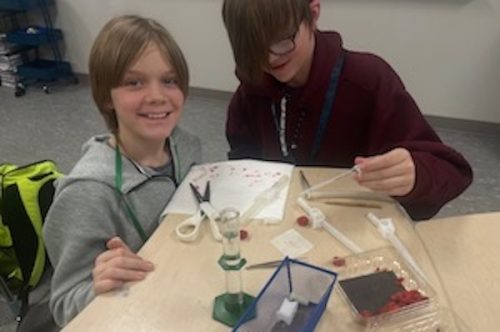
Cade Sando and Mac McGinnis harvest raspberry seeds to complete additional raspberry seed growth trials to optimize and finalize their experiment in the mini-lab.
Proposal Summary:
Our question that we are testing is “can raspberries germinate in damp paper towels in microgravity compared to gravity?” We believe that if we’re able to get raspberries to successfully germinate with a damp paper towel it could help us reserve soil. Raspberries originated from Northern Asia and North America and have a rather sweet or sour taste. They are also said to help prevent some cancers and heart diseases which could be rather helpful and from previous tests we have studied and read about we can confidently say that this info is true. This means if it is possible for raspberries to germinate quicker with a damp paper towel it could be some-what life changing. We have previously conducted an experiment here on Earth germinating raspberry seeds inside of a damp paper towel. We now want to see if this process will be sped up in microgravity. Our experiment research is important to understanding germination of seeds because we may need other forms of growing and germinating seeds besides soil, especially in microgravity.
HONORABLE MENTION FINALISTS:
How will Cladosporium sphaerospermum Strain TC09’s Growth with Sugar Water be Affected by Microgravity?
Grade 6, Steam Middle School, Burleson Independent School District
Co-Principal Investigators: Feyi Adesola, Azrael Kelley, Noah Medina, Justus Somoni, Fisher Wilkins
Teacher Facilitator: Alesha Youngs
Proposal Summary:
For our proposal summary we are exploring the growth of Cladosporium Sphaerospermum Strain TC09 in sugar water in microgravity. We want to send this mold into microgravity because on Earth when the mold is present it accelerates the growth of other plants causing them to have growth 2 to 5 times faster than normal. We also believe that if we add sugar to the molds’ environment it could potentially boost the speed in which the mold can grow in microgravity as well. Something we have in our experiment is that we are going to have no fixative and use a sample of the mold to observe if we are able to enhance plant growth with it. If this mold in sugar water can grow and thrive this could be revolutionary for farming in space. Our research could assist in farming on Earth and in space and might even solve world hunger.
Effect of Streptomyces hygroscopicus in Microgravity
Grade 6, Steam Middle School, Burleson Independent School District
Co-Principal Investigators: Austin Wise, Christopher Greene, Orian Garcia, Reagan Weber
Teacher Facilitator: Alesha Youngs
Proposal Summary:
Our proposal is to research the effects on the reproduction of Streptomyces hygroscopicus in microgravity. Streptomyces hygroscopicus is a helpful bacteria that is used to aid with the recovery after kidney and liver transplants. It does this by suppressing the immune system’s T cells during surgeries. This is important because the immune system uses a high amount of energy, and Streptomyces hygroscopicus can improve the rate of recovery and therefore improve energy efficiency. We want to know if Streptomyces hygroscopicus grows differently in microgravity than on Earth. On Earth, it takes Streptomyces hygroscopicus 4-6 hours to grow. It is mostly found outside in soil. Streptomyces hygroscopicus grows best in 25℃ to 35℃ (77℉ to 95℉) conditions. Microgravity can affect Streptomyces hydroscopes in many different ways. Research on Streptomyces hygroscopicus is important because it will aid in the research of transplants. We believe that this type of research is important because this bacteria is effective in what it does already. We are not only wondering if it can reproduce in microgravity, but if the bacteria will have an overall stronger effect.
30. Houston, Texas
Jump to Houston’s Community Profile
SELECTED FOR FLIGHT:
Comparison of Arabidopsis thaliana Germination and Cell Wall Growth in Microgravity versus Standard Conditions
Grades 10-13, San Jacinto College – South Campus
Co-Principal Investigators: Maheen Bukhari, Marcus Pitre, Amna Qureshi
Teacher Facilitator: Carrie Owens
Proposal Summary:
For our experiment, we will be using the plant species Arabidopsis thaliana to measure the difference of growth in the cell wall in microgravity compared to cell wall growth on Earth. Our experiment will provide crucial intel to determine if cell wall growth is better in space or more beneficial on Earth. The cell wall is an important aspect of any plant because it plays the “skeletal” role of a plant that supports plant growth and acts as the first line of defense when a plant encounters several types of pathogens that could prevent the healthy growth of the plant. We hope to determine if the variable of microgravity will affect this growth in any way, and how this may help us in the future for food growth in space.
HONORABLE MENTION FINALIST:
The Effects Microgravity will have on Staphylococcus aureus Ability to Form Biofilm on Teeth
Grades 13-14, San Jacinto College – South Campus
Principal Investigator: Emily Van
Co-Investigators: Emily Airhart, Rachel Hoot, McKinzie Simon
Teacher Facilitator: Maxine Lane, M.S.
Proposal Summary:
In this experiment, investigators will examine the growth of Staphylococcus aureus’ biofilm formation in a microgravity setting. Biofilms are the result of colonization from a bacterium; one of those being Staphylococcus aureus, a bacteria considered one of the most devastating pathogens from the Staphylococci genus and prevalent pathogens in the International Space Station. S. aureus is a facultative, opportunistic pathogen that can withstand high concentrations of salt and extremes pH, under normal conditions thanks to their biofilm; therefore, the investigators will aim to determine if a microgravity setting will impede, enhance, or have no significant impact Staphylococcus aureus’ ability to form a biofilm on teeth.
31. Plano, Texas
Jump to Plano’s Community Profile
SELECTED FOR FLIGHT:
Growth and Life Cycle of Crickets (Acheta Domesticus) in Microgravity for Astronaut Consumption
Grade 12, Plano ISD Academy High School, Plano Independent School District
Co-Principal Investigators: Abhinav Ajish, Jacob Castro, Nawal Siddiqui
Teacher Facilitator: Mary Imran
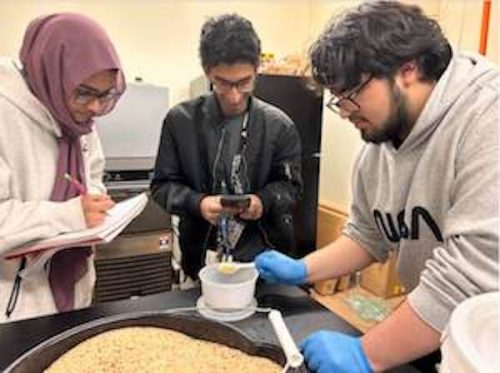
Nawal, Abhi, and Jacob measuring feed for the crickets they are farming. They need to harvest the eggs for their project- to see the impact of the lack of gravity on a cricket’s development from egg to larvae.
Proposal Summary:
The proposed experiment seeks to address the question: How does microgravity affect the life cycle and development of crickets and their protein makeup for consumption? Due to the high protein makeup of crickets, they are a potential source of nutrition for astronauts. During long-duration space travel, a sustainable food source is necessary, and the experiment seeks to determine if crickets can be used for such purposes. Crickets are made up of 55-73% protein, which is more than chicken, beef, pork, or salmon. They are significantly smaller and more nutritious than alternative protein sources, so they are much more space and cost-efficient. Their high content of essential amino acids will aid in muscle maintenance and overall health, which is especially crucial in the microgravity environment where muscle and bone loss can occur in humans. Crickets can be grown in space to create a sustainable food source for astronauts. Three cricket eggs will be sent to space to determine the effect of microgravity on crickets. Three more will also be raised on Earth under the same conditions. By comparing crickets grown on Earth with those produced in space, the researchers will determine what effects a microgravity environment has on the muscle development, size, weight, and life cycle of crickets. The lack of gravity could result in a prolonged life cycle for the crickets due to removing the stressor or muscle atrophy, negatively impacting the nutrition. Analyzing the two samples will aid in answering the research question.
HONORABLE MENTION FINALISTS:
The Effects of Germination of Kale and Spinach Seeds in Microgravity
Grade 12, Plano ISD Academy High School, Plano Independent School District
Co-Principal Investigators: Adamaris Gonzalez, Justine Park, Savannah Jones
Teacher Facilitator: Mary Imran
Proposal Summary:
The purpose of this experiment is to investigate the effects of space travel on seeds and identify the types of seeds that are more suited to germination in microgravity. The seeds of kale and spinach are all currently being evaluated. We will be able to save space and have complete control over the amount of nutrients delivered to the seeds using hydroponics. In addition to focusing on the process of germination, we will also be monitoring the rate of growth as well as the general health of the seeds. By carrying out this experiment, scientists can get useful insights into systems that might produce food in a sustainable manner for future space trips. In addition, the findings may have implications for agricultural practices on Earth, potentially leading to the development of farming techniques that are more effective in settings with limited resources. The purpose of this experiment is to identify which of the three seeds has the potential to grow at the quickest rate when subjected to conditions of microgravity. This information will be essential for planning long-term space trips in which astronauts will need to rely on their own cultivation of food supplies. In addition, gaining an understanding of the growth patterns and overall health of these seeds when they are exposed to microgravity can provide insights into the effects that space travel has on the biology of plants. This research may, in the long run, help contribute to the development of farming systems that are more advanced.
Effects of Baby Leaf Lettuce Growth and Stress Resistance when Exposed to Methylobacterium Biofertilizer and Microgravity
Grade 12, Plano ISD Academy High School, Plano Independent School District
Co-Principal Investigators: Anna Lovnander, Efrain Amezcua-Ramirez, Rebecca Hicks
Teacher Facilitator: Mary Imran
Proposal Summary:
The proposed experiment seeks to investigate the simultaneous effects of Microgravity and Methylobacterium as a biofertilizer on the growth and stress resistance of baby leaf lettuce. This study holds significant implications for both sustainable agriculture on Earth and future space missions. Baby leaf lettuce is a widely consumed and cultivated crop, and understanding its response to novel cultivation techniques is vital. This fast-growing plant can be harvested before reaching full maturity, which is known as “baby lettuce,” and grows at a rate that will take 4-6 weeks. Most Methylobacterium species promote plant growth by increasing levels of cytokinin phytohormones as well as the spread of healthy rhizobacteria, which increases crambe yields, root system, and plant height, as well as improves stress resistance. Four Methylobacterium strains have also been found on the ISS, proving it can survive the harsh conditions of microgravity. Data recorded on the space station is essential for research that will aid future missions necessitating sustainable resources, with food being one of the most crucial of which to have a constant supply. Hence, studying plant symbiosis with organisms, which include Methylobacterium, can be a key element for future extraterrestrial missions by improving its chances of survival in different doses of gravity and environmental conditions.
32. San Antonio, Texas
Jump to San Antonio’s Community Profile
SELECTED FOR FLIGHT:
Effects of Microgravity on Chia Seed Growth
Grades 11-12, Theodore Roosevelt High School, North East Independent School District
Co-Principal Investigators: Permission to post names pending
Teacher Facilitator: Christopher Wilson
Proposal Summary:
The extent of the effects of microgravity on specimens from Earth are still to be discovered, and as such, this investigation will evaluate the effects of microgravity on the growth of chia seeds. Plants capable of producing stems typically utilize turgor pressure to grow upwards from the ground in response to the presence of gravity. The observations to be gathered from this experiment will be extremely useful for the future of astrobotany, as astronauts will need a sustainable source of nutrition on longer journeys. The expectation is for the chia seeds to grow at a rate of similar value as observed on Earth.
HONORABLE MENTION FINALISTS:
How Microgravity Affects the Hatching Rate of Carpenter Ant Cocoons
Grade 7, Space and Engineering Technologies Academy, North East Independent School District
Principal Investigator: Permission to post names pending
Co-Investigators: Permission to post names pending
Teacher Facilitator: Kimberly Wetherald
Proposal Summary:
A set of carpenter ant cocoons will be sent into space to test if the hatching rate is affected or differs from the hatching rate of the cocoons on Earth. This will be done to help scientists better understand if cocoons will hatch in microgravity, which will be beneficial if we attempt to live in space. From the research that has been conducted, the general belief is that ant cocoons will hatch, just at a slower rate in microgravity. Even though these ants are tiny, they will play a vital role in keeping our potential space settlement gardens protected from other unwanted pests and as similar to Earth as possible.
Influence of Microgravity on Enzymes and its Future Applications
Grades 9 and 11, Roosevelt High School, North East Independent School District
Principal Investigator: Permission to post names pending
Collaborators: Permission to post names pending
Teacher Facilitator: Christopher Wilson
Proposal Summary:
The goal of this project is to discover if enzymes can be used in a microgravity environment. This is important due to the fact that enzymes are commonly used in many fields that could be of use to astronauts in the future. Some of these fields of use include medicinal uses, sustainability uses, sanitation uses. These applications are immensely important for the advancement of humanity through space simplifying processes and improving the quality of life in microgravity. This is especially important for lengthier missions because any minor improvements will assist moral & efficiency of the astronauts.
33. Texarkana, Texas
Jump to Texarkana’s Community Profile
SELECTED FOR FLIGHT:
Will Normal Strength Concrete Keep its Structure in Microgravity
Grade 5, Martha and Josh Morris Mathematics and Engineering Elementary, Texarkana Independent School District
Co-Principal Investigators: Lily “Lizzy” Izabella Elaine LaGrone, Lynnley Rae Galloway
Investigator: Isaac Lynn Steele
Collaborator: Cooper Allen Wood
Teacher Facilitator: Marie Goodwin
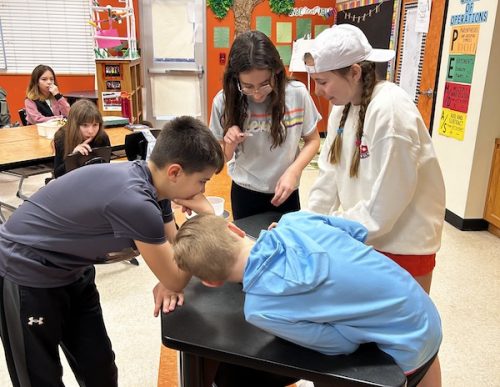
Lizzy, Lynnley, Isaac, and Cooper working on ways to calculate the strength of concrete in microgravity.
Proposal Summary:
Our team has chosen a type of concrete called Normal Strength Concrete (NSC). Normal Strength Concrete is the most commonly used type of concrete in the world. Normal Strength Concrete is made out of cement, water, and aggregate. The strength of this type of concrete varies from 10 MPa and 40 MPa (Master of Public Administration). If we started a community in microgravity we would need houses, roads, sidewalks, work buildings and more. If we did not have concrete for our buildings, they would not be strong or durable. We chose concrete because we want to see if concrete would still have the same chemical reaction in microgravity that it does on earth. In the tube there will be one clamp on one side we will put dry ingredients (aggregate, hydraulic cement, on the other side we will put water. When the tube gets in space the astronauts will take the clamp off and shake it for thirty-five seconds. If microgravity had a weak effect on the concrete, we would not be able to make a foundation on mars and/or the moon. If the concrete became stronger we could build a foundation on Mars and/or the moon. We are hoping that microgravity has a positive effect on the concrete so that we can make a foundation on the moon.
HONORABLE MENTION FINALISTS:
Will Mesquite Honey Crystallize in Microgravity?
Grade 5, Martha and Josh Morris Mathematics and Engineering Elementary, Texarkana Independent School District
Principal Investigator: Elizabeth Kyles
Investigators: Bear Glass, Micah Hammonds
Collaborator: Nora McCarley
Teacher Facilitator: Marie Goodwin
Proposal Summary:
We propose to see if Manuka honey (a helpful remedy/well-known medicine) crystallizes in microgravity. Our project is to see if we can use this remedy/medicine with or without it crystallizing in microgravity. We will use honey and water at 5 degrees Celsius to see if it will consolidate in microgravity and get a fast but accurate result. This project is to see if honey will crystallize in microgravity. Honey can help people with their health, and is an anti-inflammatory and an antibacterial agent. It is helpful because it is needed for coughs, burns, wound healing, and swelling and sores in your mouth. Another reason we want to do this is that it is not only a remedy but a good source of glucose that will serve as a blood sugar riser for people with Diabetes. We will use a single-clamped test tube, or type two FME mini-lab, and send our chosen items to see our experiments’ effect in microgravity. In our first section, there will be honey. In the second section, there will be water that will quicken the crystallization process. Once it is all combined we want to leave the honey to crystallize in the water. After it has crystallized we should be able to see the effect of crystallization in microgravity. Honey is an excellent substance to send to space because it can help with your health and medication purposes. Astronauts could benefit from the use of honey if it were easier to use in microgravity.
Would Kentucky Bluegrass Grow the same in Microgravity as it does here on Earth?
Grade 6, Texas Middle School, Texarkana Independent School District
Principal Investigator: Sara Spakes
Investigators: Stella Davis, Lilly Rollans, Annistyn McFarland
Teacher Facilitator: Suzanne Boyd
Proposal Summary:
The experiment is about the growing habits of Kentucky Bluegrass seeds in microgravity. The investigators want to perform this experiment to see if Kentucky Bluegrass will germinate and grow. The team will evaluate the growing habits of Kentucky Bluegrass on Earth and the growing habits of Kentucky Bluegrass in microgravity, and compare them. The team will use the brand Antebellum for the Bluegrass in this experiment. Answering this question could benefit humans because if people ever live on Mars, like scientists plan to, then people will need plants. If this experiment is successful then it will be easier to grow food in microgravity because grass is a great source of nutrients for other plants.
34. Waxahachie, Texas
Jump to Waxahachie’s Community Profile
SELECTED FOR FLIGHT:
Tardigrade Growth in Space
Grade 6, Eddie Finley Junior High School, Waxahachie Independent School District
Co-Principal Investigators: Peyton Dues, Caris Gray, Olivia Jones
Teacher Facilitator: Ashley Dawson
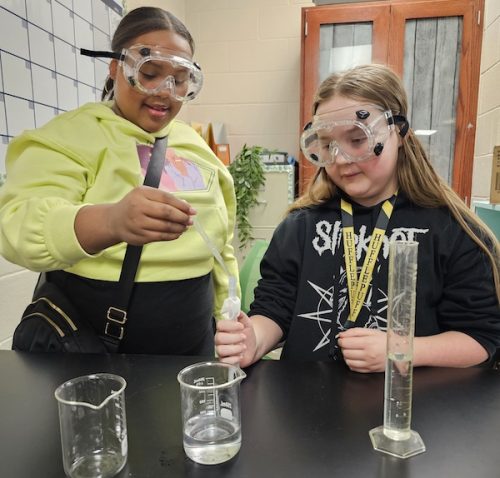
Student researchers (Caris Gray and Olivia Jones) adding tardigrade to the experiment tube to begin terrestrial examination of tardigrade growth.
Proposal Summary:
We would like to explore if tardigrade eggs are able to hatch and develop with gravity turned off for a period of time. The materials we will be using are tardigrade eggs and an FME3-type tube. Based on previous research, tardigrades are able to survive in any temperature, and they can survive up to thirty days without food or water. Since the fact that tardigrade eggs are able to hatch and develop in space is unknown to us, this experiment will help us figure out that information. We only know so far that tardigrades can survive in space. This experiment will benefit society by giving us information about how eggs develop in microgravity.
What is the Effect of Microgravity on Dandelion Growth?
Grade 6, Robbie E. Howard Junior High School, Waxahachie Independent School District
Co-Principal Investigators: Caiden Holmquist, Coralee Holloway, Levi Blaise Lewis, Cadee Smith
Teacher Facilitator: Michelle Dominy
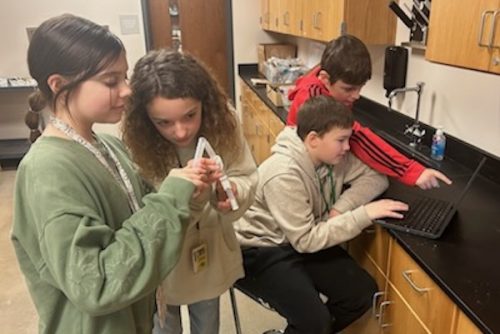
Student researchers (Cadee Smith, Coralee Holloway, Caiden Holmquist, and Levi Blaise Lewis) taking measurements and recording data for their experiment.
Proposal Summary:
This experiment will measure the effects of microgravity on the early development of Taraxacum Officinale (dandelions). Dandelions may grow faster in space because there is no gravity there. Gravity pulls things down so the dandelions will not be held back. This investigation will compare how a dandelion seed grows on Earth and in space. Dandelion seeds will be used because dandelion seeds are very beneficial to health. We have heard that some ways they are beneficial are to help fight cancer, help with skin care, help with your immune system, help with blood pressure, and contain many vitamins! The FME tube will be separated into three different parts. The first part will contain seeds. Next to that will be water. And the last tube will hold a fixative. The fixative that will be used is formalin. It will help stop the growth but won’t destroy it.
HONORABLE MENTION FINALISTS:
Aloe Vera in Microgravity
Grade 6, Eddie Finley Junior High School, Waxahachie Independent School District
Co-Principal Investigators: Landon Hale, Miya Haynes, Larkyn Landers, Cody Metsinger
Teacher Facilitator: Ashley Dawson
Proposal Summary:
We want to send an aloe vera seed to the ISS for its amazing properties. It will test the effectiveness of long plants in small containment in space. We will use an aloe vera seed and a watered cotton ball. The aloe vera seed can be used in space in many different ways, such as improving air quality in space, and can be used on the human body. It helps improve mouth sores, rashes, and acne. We think the aloe vera plant and seed can do amazing things for the ISS.
Tiny Swim for Fish, Big Leap for Space Exploration
Grade 6, Robbie E. Howard Junior High, Waxahachie Independent School District
Co-Principal Investigators: Henley Andrews, Alayah Collins, Jack Pinson, Leonardo Sandoval
Teacher Facilitator: Kristi Holland
Proposal Summary:
The purpose of this experiment is to see if microgravity affects the growth of a Paedocypris progenetica. One main reason for this study is to see if the tiny fish can stay alive in microgravity. This experiment will help scientists further research animal growth in space so that one day, they can send our pets to space! If the experiment is not able to stay alive in space, it will not be brought back to the ISS in the future. The question that is being asked is, “Will microgravity affect the growth of a Paedocypris progenetica?” The materials that will be used in this experiment are 10 ml of water and some algae for the fish to eat. The type of tube being used is type one, so there will be no interaction between the astronauts and the tube.
Longicaudatus Adaptations in Microgravity
Grade 6, Coleman Junior High School, Waxahachie Independent School District
Co-Principal Investigators: Avee Heard, Markus Malone, Savannah Allen
Teacher Facilitator: Jeffery Linam
Proposal Summary:
As responsible and curious scientists, we propose an experiment to send a Triops longicaudatus egg to space. This experiment aims to observe microgravity’s effects on this small creature’s development. The Triops longicaudatus is known as the tadpole shrimp, with some species measuring 1-2 mm in length. It is also known to have a unique and complex reproductive cycle The females reproduce by parthenogenesis and keeps her eggs sack until the conditions are favorable to lay the eggs in the water. By sending a Triops longicaudatus egg to space, we can observe how the lack of gravity affects the embryo’s development and how it impacts the hatching process. This experiment could provide valuable insights into the biological processes of these tiny creatures and how they adapt to extreme environments. Of course, we would take all necessary precautions to ensure the safety and well-being of the animal. We would work with experts in animal welfare and space travel to ensure that the egg is properly housed and cared for during the mission. Overall, this experiment could provide valuable scientific insights while also helping us better understand the unique and fascinating world of the Triops longicaudatus crustacean. Here is a list of the materials we will need: A dormant Triops longicaudatus egg, a Type 3 FME mini-lab, shrimp food, tap water, and 10% Formalin.
How will Bread Rise in the Weightlessness of Space?
Grade 6, Eddie Finley Junior High School, Waxahachie Independent School District
Co-Principal Investigators: Kenley Baggett, Samuel Helland, Brandon Lara, Ava Morgan
Teacher Facilitator: Jessey Cadwell
Proposal Summary:
Astronauts could really benefit from having bread already available on their spaceship. Bread provides dietary fiber, which helps the digestive system [includes the parts of plant foods the body can’t digest or absorb] and provides plenty of energy. The bread would also help with blood flow and help control cholesterol levels [cholesterol numbers show how much cholesterol is circulating in your blood]. With only a few required ingredients, bread is simple to make on earth. You really only need flour, water, salt, and yeast. However, in space, you don’t have the room or the power to make bread. This experiment will test how bread will rise in microgravity. Microgravity is when objects seem to be weightless. Bread rising is when yeast releases enzymes that convert the flour starch into sugar, which the cells absorb and metabolize. This process releases CO2 gas, which forms bubbles that become trapped in the stretchy dough. During baking, the oven’s heat expands the bubbles even further. For this project, you will need instant yeast, flour, salt, water, 10% neutral buffered formalin, and type 3 FME Mini-lab tube.
35. Sandy, Utah
Jump to Sandy’s Community Profile
SELECTED FOR FLIGHT:
Nematodes to the Rescue! – Space Worms as an Integral Component of Space Agriculture
Grade 10, Hillcrest High School, Canyons School District
Co-Principal Investigators: Jasmine He, Rosemary Lu, Bella Nguyen
Collaborators: Samhita Chavakula, Vidushi Shelat
Teacher Facilitator: Clief Luis Castleton
Proposal Summary:
Entomopathogenic nematodes (EPNs) are insect parasites that are used widely in agricultural pest control. These nematodes kill their insect hosts with the aid of symbiotic bacteria that they carry in their guts. EPNs are eco-friendly biocontrol agents safe for humans and are great substitutes for chemical insecticides. To dive further into the effects of EPNs, this investigation will explore the efficiency of the EPNs in microgravity. Understanding the host parasite relationship in microgravity allows investigators to gain better insight into plant protection in space, as space agriculture is becoming increasingly important for bioregenerative life support systems during long-term human space flights. Previous research indicated that EPNs are able to find hosts and reproduce in space. Thus, EPNs may be a practical solution for controlling insect pests when crops are grown in space. However, more research is needed to conclude the capabilities of EPNs under microgravity. Building upon previous work confirming that EPNs are able to reproduce and survive in microgravity, the investigators propose the question: How will microgravity affect the effectiveness of EPN reproduction and virulence, as well as relative reproduction and virulence among species? This helps determine the effectiveness of the EPNs and its potential applications for biocontrol in space. To assess insect mortality, nematode establishment and reproduction, investigators will use two species of EPNs from the Steinernema genus, specifically S. carpocapsae and S. glaseri. Investigators will mimic an EPN’s environment in microgravity by using sterile play sand and mealworms as the model insect host for this experiment.
HONORABLE MENTION FINALISTS:
The Effect of Microgravity on the Sarcoplasmic Reticulum
Grades 9-10, Hillcrest High School, Canyons School District
Co-Principal Investigators: Johan Jaison, Kushal Narkhede, Sashwath Narayanan, Om Sanghvi, Shreya Sanghvi
Teacher Facilitator: Clief Luis Castleton
Proposal Summary:
Muscle cell death is a dire problem in space for many astronauts. They can lose up to 20% of muscle mass, and up to 30% of muscle strength in just one month while in space (Donahue +5 2021). This experiment proposes to answer the question of how the long-lasting effects of microgravity affect the activity of the sarcoplasmic reticulum (SR) in muscle cells. The experiment will test the storage and regulation of Ca2+ (cytosolic calcium) ions in the SR. Specifically, the amount of cytosolic calcium ions stored inside and released from the sarcoplasmic reticulum will be measured. This will help to know if a microgravity environment is causing deregulation, normal amounts of regulation, or hyperregulation in the sarcoplasmic reticulum. Ca2+ ions are crucial in the contraction of all muscle cell types. Deregulation of this can cause cell death relating to many different diseases like muscle atrophy and malignant hyperthermia. Removal of Ca2+ ions from the cytosol is one of the main functions of this vital organelle. In fact, the sarcoplasmic reticulum, which is a specialized form of the endoplasmic reticulum, is organized into many interconnected tubules. These tubules are dedicated to the removal of Ca2+ ions from the cytosol. This experiment will measure the difference between the amount of removal of Ca2+ on Earth’s gravity and the amount of removal of Ca2+ after long lasting effects in microgravity. This will ultimately conclude how a microgravity environment impacts the activity of the sarcoplasmic reticulum.
The Effect of Microgravity on the Fermentation of Crude Glycerol by Anaerobium Acetethylicum
Grade 9, Hillcrest High School, Canyons School District
Principal Investigator: Dillon Liew
Investigator: Zhuocheng Wang
Collaborators: Wenray Zhang, Lema Grow, Katherine Drobyshev
Teacher Facilitator: Clief Luis Castleton
Proposal Summary:
This experiment will test the effects of microgravity on the use of the bacteria Anaerobium Acetethylicum to ferment crude glycerol. This bacterium is shown to mainly produce ethanol and hydrogen, both valuable products, and doesn’t co-produce unwanted by-products. The ability of this bacterium to ferment crude glycerol into valuable products has been made important by the increase in production of crude glycerol in the biodiesel industry. Crude glycerol made from biodiesel production is considered a waste product because of its many impurities. As a result, the cost and importance of crude glycerol is very low but with this strain of bacteria and its glycerol fermentation capabilities, crude glycerol could turn into a co-product instead. These bacteria could increase the value of biodiesel industries by turning the surplus amount of crude glycerol produced into useful products through fermentation.
36. Chesapeake, Virginia
Jump to Chesapeake’s Community Profile
SELECTED FOR FLIGHT:
The Growth Of Beets In Microgravity
Grade 5, Crestwood Intermediate School, Chesapeake Public Schools
Co-Principal Investigators: Permission to post names pending
Teacher Facilitators: Daniel Weaver, Cristina Drewry
Proposal Summary:
The proposed investigation is to figure out the effects of microgravity on beetroots. Since beets have such good benefits such as physical health, mental health, and medicinal benefits for those who eat them. It could be a great asset in space if it could survive. They grow very quickly so you won’t have to wait for a long time to harvest them. First, the mini-lab gets put together. Second, one mini-lab gets sent to space and one stays here. Third, the clamps get unclamped at specific dates. Lastly, the two samples get analyzed and compared to each other.
HONORABLE MENTION FINALISTS:
Outcome of Okra (Abelmoschus Esculentus L. Moench) Germination in a Microgravity Environment
Grade 5, Crestwood Intermediate School, Chesapeake Public Schools
Co-Principal Investigators: Permission to post names pending
Teacher Facilitators: Daniel Weaver, Cristina Drewry
Proposal Summary:
The suggested experiment is to find out the effect of microgravity on the germination of the Abelmoschus Esculentus plant. The Abelmoschus Esculentus plant contains many useful vitamins that are necessary for survival including vitamin A, C, K, and B6. It has many benefits including hair growth, cancer treatment and prevention, diabetes prevention, heart attack healing, and stroke healing. It can also help get rid of dangerous microplastics in water when paired with other plants. In addition, the Abelmoschus Esculentus plant contains flocculants meaning that it clumps up taking it with them.
Bamboo Growth In Space
Grade 5, Crestwood Intermediate School, Chesapeake Public Schools
Co-Principal Investigators: Permission to post names pending
Teacher Facilitators: Daniel Weaver, Cristina Drewry
Proposal Summary:
This proposed experiment was to test how bamboo will act in microgravity. What the group will be doing for the experiment is to get a mini tube, a bamboo seed, grow a small plant and then do some comparison when our plant comes back from space. The group wanted to test this because water is extremely needed and after a rainy day, bamboo will absorb that water that it got from the rainy day. Then the water that is inside of it will be used for drinking, but people, including the group, doesn’t know if the same thing would happen in space.
37. iForward-Grantsburg, Wisconsin
Jump to iForward-Grantsburg’s Community Profile
SELECTED FOR FLIGHT:
Will Microgravity have an Effect on the Growth and Development of Brine Shrimp?
Grade 9, iForward Public Online Charter School, Grantsburg School District
Principal Investigator: Camron Masalewicz
Teacher Facilitator: Sara Gregorich, MS
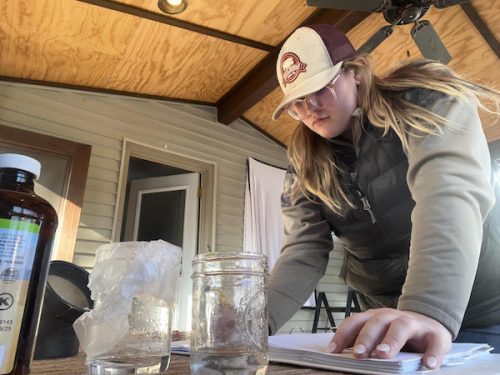
Jordan Brown is testing different solution amounts while studying the growth and development of brine shrimp.
Proposal Summary:
For this experiment, we will be studying the growth and development of brine shrimp under the effects of microgravity. We’ve found that, “Brine shrimp are flexible in that they are able to cope with an ever-changing environment, survive harsh conditions, and live on a variety of food sources.” This brings us to ask ourselves if brine shrimp would be able to survive in microgravity. In our ground experiment, we noticed that it took 3-4 days for only a few brine shrimp to hatch. However, would it take that long for them to hatch in microgravity? For our experiment, we will be using a type 3 FME. We will have salt water in one portion, the brine shrimp eggs in another, and rubbing alcohol in another. When our experiment arrives we would prefer the astronauts unclamp clamp A so the contents from the first chamber and second chamber can mix, we would also like it if they could gently shake for 5 seconds at this time. Throughout the first week of our experiment being on the ISS, we would like astronauts to shake gently for 5 seconds. A week before the undocking clamp C can be unclamped that way we can see the difference in growth compared to the shrimp we kept on Earth. Our hypothesis is that the majority of the brine shrimp will grow bigger due to the effects of microgravity. Other similar past experiments done with brine shrimp had varying effects from the microgravity environment.
HONORABLE MENTION FINALISTS:
How will the Neutralization of Lactobacillus rhamnosus be Affected by Dawn Antibacterial Soap in Microgravity?
Grades 8-9, iForward Public Online Charter School, Grantsburg School District
Co-Principal Investigators: Jordan Brown, Isaac Kostron, Jovani Organista
Teacher Facilitator: Andrea Konrath
Proposal Summary:
In this experiment the neutralization of Lactobacillus rhamnosus by Dawn Antibacterial Soap in microgravity will be studied. In microgravity, bacteria can mutate so it’s important to study how bacteria behave. The priority of any space mission is to keep the crew healthy. According to the article titled Our Relationship to Microbes on the International Space Station, NASA believes “there is still a possibility that the assortment of microbial hitchhikers could include disease-causing pathogens that might make the crew sick.” Therefore, having a strong defense against these pathogens will become the top priority in future space travel. If this experiment is successful we will learn how to deal with bacteria more easily and how it responds to antibacterial soap in space. The FME tube utilized for the experiment is a type 3. The first volume is filled with 2 ml of Dawn Antibacterial Soap to act as the neutralizer. Within the second volume 2 ml Lactobacillus rhamnosus will be included to act as the bacteria. Finally volume three will contain 2 ml glutaraldehyde to act as a fixative of the experiment. The hypothesis is that the Lactobacillus rhamnosus on the ISS won’t be neutralized by the Dawn Antibacterial Soap because it will have a more difficult time coming into contact with the soap in the microgravity environment.
How will Copper Wires Corrode in Microgravity?
Grade 7, iForward Public Online Charter School, Grantsburg School District
Co-Principal Investigators: Natalie Adamski, Mercy Crum, Rylee Schyma
Teacher Facilitator: Tammy Dymesich
Proposal Summary:
In this project, the goal is to determine the corrosion rate of copper wires. This could be beneficial to astronauts for various reasons. Copper wires can be used for many electrical items and are popular because of how well they conduct electricity. “Copper wire is used in power generation, power transmission, power distribution for telecommunications, electronic circuitry, and countless types of electrical equipment”. Copper wires also have high heat and corrosion resistance, furthering their reliability as wires. If this project is to be successful, we will know the corrosion rate of copper wires. The materials we are going to be using are copper wires, distilled water, and vegetable oil. The first section of the FME will have 3g of copper wires, the next section will have 2.4 ml of distilled water, and the last section will have 3 ml of vegetable oil. Within the first week of the experiment in microgravity, the astronauts will unclamp clamp A and shake gently for 20 seconds. In the week prior to undocking, the astronauts will unclamp clamp B and shake gently for 20 seconds, to make sure the oil gets incorporated enough with the wires to stop the experiment. The hypothesis is that if the copper wires corrode in microgravity, they would corrode the same as on Earth, and we would have to stop the corrosion. Copper wires should corrode the same as on Earth as in microgravity because although there is no oxygen in space, objects can still corrode.

